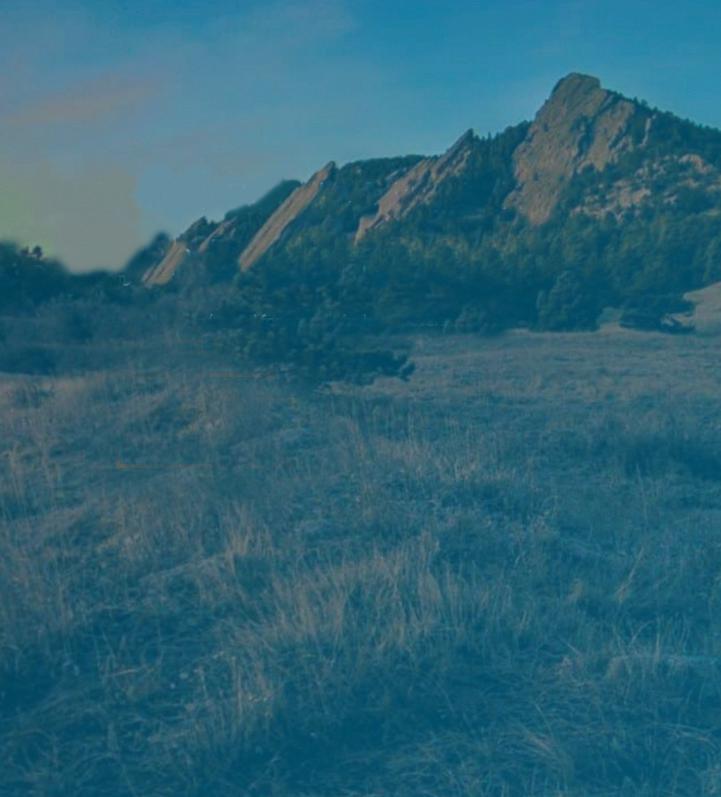LONGMONT
DISPATCH FROM THE DISH LINE
ON THE FARM WITH GREGORY ALAN ISAKOV


LONGMONT
DISPATCH FROM THE DISH LINE

CLIMBING BOULDER CANYON P.14






10 NEWS: Neighbors and developers use collaborative process to seek middle ground on future of Longmont’s Bohn Farm


 BY KAYLEE HARTER
BY KAYLEE HARTER


14 ADVENTURE: A history of climbing in Boulder Canyon with pioneering route-setter Mark Rolofson BY WILL MATUSKA

17 MUSIC: Back on the farm with Gregory Alan Isakov
BY AARON IRONS19 THEATER: BDT Stage closes the curtain on a half-century of dinner theater with ‘Fiddler on the Roof’ BY TONI TRESCA
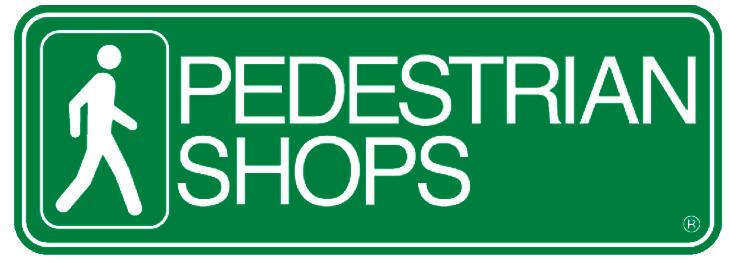
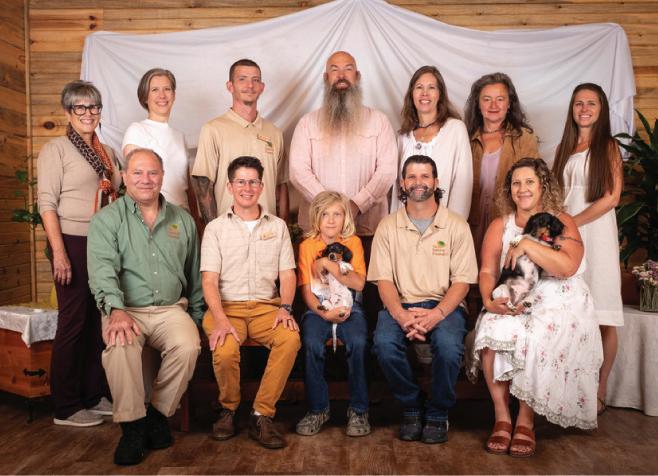






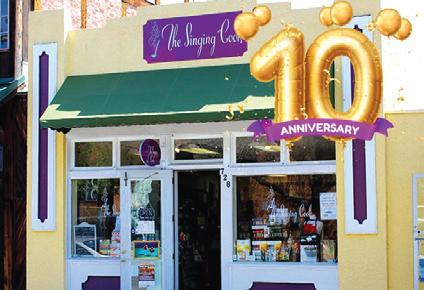






















AUGUST 31, 2023
Volume 31, Number 2
PUBLISHER: Fran Zankowski
EDITORIAL
EDITOR-IN-CHIEF: Caitlin Rockett
ARTS & CULTURE EDITOR: Jezy J. Gray
GENERAL ASSIGNMENT REPORTERS: Kaylee Harter, Will Matuska
FOOD EDITOR: John Lehndorff
INTERN: Lily Fletcher
CONTRIBUTING WRITERS: Dave Anderson, Will Brendza, Rob Brezsny, Michael J. Casey, Aaron Irons, Dan Savage, Bart Schaneman, Toni Tresca, Colin Wrenn
SALES AND MARKETING
MARKET DEVELOPMENT MANAGER: Kellie Robinson
SENIOR ACCOUNT EXECUTIVE: Matthew Fischer
ACCOUNT EXECUTIVE: Chris Allred
SPECIAL PROJECTS MANAGER: Carter Ferryman
MRS. BOULDER WEEKLY: Mari Nevar
PRODUCTION
CREATIVE DIRECTOR: Erik Wogen
SENIOR GRAPHIC DESIGNER: Mark Goodman
CIRCULATION MANAGER: Cal Winn
CIRCULATION TEAM: Sue Butcher, Ken Rott, Chris Bauer
BUSINESS OFFICE
BOOKKEEPER: Emily Weinberg
FOUNDER/CEO: Stewart Sallo
As Boulder County’s only independently owned newspaper, Boulder Weekly is dedicated to illuminating truth, advancing justice and protecting the First Amendment through ethical, no-holdsbarred journalism and thought-provoking opinion writing. Free every Thursday since 1993, the Weekly also offers the county’s most comprehensive arts and entertainment coverage. Read the print version, or visit boulderweekly. com. Boulder Weekly does not accept unsolicited editorial submissions. If you’re interested in writing for the paper, please send queries to: editorial@boulderweekly.com. Any materials sent to Boulder Weekly become the property of the newspaper.
690 South Lashley Lane, Boulder, CO 80305 Phone: 303.494.5511, FAX: 303.494.2585 editorial@boulderweekly.com www.boulderweekly.com
Boulder Weekly is published every Thursday. No portion may be reproduced in any form without written permission from the publisher. © 2023 Boulder Weekly, Inc., all rights reserved.
Boulder Weekly welcomes your correspondence via email (letters@boulderweekly. com). Preference will be given to short letters (under 300 words) that deal with recent stories or local issues, and letters may be edited for style, length and libel. Letters should include your name, address and telephone number for verification. We do not publish anonymous letters or those signed with pseudonyms. Letters become the property of Boulder Weekly and will be published on our website.
In late August, a number of Democratic Latino U.S. Congress members, led by Alexandria Ocasio-Cortez (New York), visited Brazil, Chile and Colombia. The three countries’ governments represent the new leftist wave recently elected in the region.
The delegation included Joaquin Castro and Greg Casar (both from Texas), Nydia Velázquez (New York) and Maxwell Frost (Florida). Castro is a member of the Subcommittee on the Western Hemisphere, which is part of the Congressional Foreign Affairs Committee. They were joined by Misty Rebik, Sen. Bernie Sanders’ chief of staff.
Sanders offered his support, saying: “The United States shares critical challenges with our friends in Latin America, but we have too often prioritized corporate interests or great power competition in our historical engagement with the region. I hope this delegation will help present a new face to the hemisphere, one based on engagement for the sake of people and planet.”
The delegation said the future of democracy in the United States is inextricably tied to the rest of the continent. They cited the “twin” insurrections, one in Washington, D.C. on Jan. 6, 2021, the other in Brasília on Jan. 8, 2023, when thou-
sands of supporters of president Jair Bolsonaro, fueled by an avalanche of misinformation about election fraud, stormed and trashed government buildings to keep the far-right “Trump of the Tropics” in power even though he lost the election.
The U.S. envoys met with presidents Lula da Silva (Brazil), Gabriel Boric (Chile) and Gustavo Petro (Colombia) and parliamentary representatives. They also met with civil society organizations that work “on the frontlines of ecological transitions, democratic transformations and peace negotiations in the countries,” the delegates explain in a joint statement.
“The U.S. needs to publicly

acknowledge the harms we’ve committed through interventionist and extractive policies and chart a new course based on trust and mutual respect,” Ocasio-Cortez told the Los Angeles Times.
While in Chile, AOC said the U.S. needs to declassify documents that could shed light on Washington’s involvement in Chile’s 1973 military coup. Much has been revealed over the years, but Chile’s President Boric has demanded the release of all documents.
Sept. 11 is the 50th anniversary of the coup. It is known around the world as “the other 9/11” and is interestingly commemorated in numerous events in Britain. The democratic election of socialist Salvador Allende in 1970 created a panic in Washington. In secret communications, President Nixon’s Secretary of State, Henry Kissinger, was alarmed that Allende would create a good example of an attractive socialist democracy that might be copied in Latin America and even Western Europe.
The Nixon administration launched a massive political and economic destabilization campaign using terrorist acts, manipulation of Chile’s media and international economic institutions. Nevertheless, Allende’s popularity rose.
Guardian columnist Andy Beckert notes: “The Allende government was an argumentative and ambitious coalition which, almost uniquely, attempted to create a socialist country with plentiful consumer pleasures and modern technology, including a kind of early internet called Project Cybersyn, without Soviet-style repression.”
The conservative British newspaper The Daily Mail said the computing project was “an astonishing experiment.” It would be destroyed after the coup.
Unfortunately, the 17-year military dictatorship of General Augusto Pinochet pioneered a different experiment called “neoliberalism,” which involved harsh free-market policies that would spread across the world. Since it involved mass
misery, the citizenry had to be disciplined through murder, torture and mass incarceration. It would be a model for Ronald Reagan and Margaret Thatcher. But it was milder in the U.S. and Britain due to pesky democratic elections and opposition parties.
But many on the U.S. far-right yearn for the purer Pinochet stuff. Years ago, some on the internet “jokingly” threatened to “take someone for a helicopter ride.” During Pinochet’s rule, dissenters had been tossed from helicopters into the ocean, lakes and rivers.
The violent Proud Boys began to use the helicopter rides meme on T-shirts, flags and posters with the slogan “Pinochet Did Nothing Wrong.” There are spin-offs featuring Roger Stone, Enrique Tarrio and Trump.
After the collapse of the Soviet Bloc, Pinochet became a popular icon among oligarchs. They wanted capitalism without democracy. Greg Palast documents Putin’s rise to power in his March 22, 2022 Buzzfeed essay “How Billionaires Picked Putin as ‘Russia’s Pinochet.’”
“Vladimir Putin did not arrive from outer space on an abalone shell,” writes Palast, but rose from unknown deputy mayor of Saint Petersburg to Russia’s president by winning a competition organized by billionaire Boris Berezovsku, who sought a “Russian Pinochet” to succeed Boris Yeltsin as President.
“The competition, dubbed ‘Operation Successor,’ went so far as to send Russia’s ‘Larry King,’ Mikhail Leontyev, to interview General Pinochet for Russian TV while Pinochet was under indictment in Chile on murder charges,” Palast writes. “Russians were treated to the old dictator’s advice on choosing a leader who could imitate Pinochet’s ‘strong hand,’ a police state, while promoting a hyper-capitalist economy.”
“And Putin fit the Pinochet profile.”

This opinion does not necessarily reflect the views of Boulder Weekly.

I am excited about the mayoral race this year because for the first time in our city’s history, we will be electing our mayor. But this is also a difficult race for me because my friends and colleagues who I have worked with for years are vying for the same position. Throughout my life when I had to make hard decisions, I tried to weigh the good and the bad to find the middle ground. In this year’s election for mayor, I am not sure if I have found a middle ground by endorsing both Mayor Aaron Brockett and Council Member Nicole Speer. Nonetheless, here is why I have endorsed both, respectively.
I am deeply grateful for all the work of Mayor Brockett. We have traversed tough and challenging times together as colleagues. And we have overcome so much, especially during the COVID pandemic. He has been tested throughout his mayoral tenure. Further, Mayor Brockett is someone I can call any time no matter the subject and no matter how hard the conversation.
As for Council Member Nicole Speer, we have an opportunity to elect our first woman mayor. After all, the way we start our mayoral election journey matters. I have worked with Council Member Nicole Speer for two years. I know her to be kind and compassionate. She is authentic and strives to lead with empathy. She advocates for our community member’s physical safety, and mental health, regardless of race, or socio-economics. Council Member Speer has not wavered in her support to protect all community members from the day I met her as a work colleague. She is consistent in her values. I believe as your mayor Nicole Speer will deliver on her promises because past behavior is a predictor of future behavior. She will advocate for us all.
— Junie Joseph, Boulder City Council Member / State Representative for HD-10California boasts one of the few comprehensive rodeo laws in the country, Penal Code 596.7, enacted in 2000. It requires either an on-site or on-call veterinarian at all rodeos and charreadas (Mexican-style rodeos). The law also restricts the use of electric prods and requires that injury reports be submitted to the State Veterinary Medical Board.
Colorado, home of the Professional Rodeo Cowboys Association (PRCA), has no such law, and should be setting an example for others to follow. Note that 13 states have outlawed the charreada’s brutal “horse tripping” event, including Nebraska, which has also banned “steer tailing.” Colorado should do likewise.

The PRCA estimates that some 5,000-10,000 rodeos are held annually in the U.S., the overwhelming majority of which have no vet requirement. The PRCA (which sanctions some 600 rodeos) has required on-site vets only since 1996, after five animals were killed at the 1995 California Rodeo/ Salinas. The smaller International Professional Rodeo Association (IPRA) has no such rule. This needs to change.
Racetracks, horse shows and endurance rides all require on-site veterinarians — so should all rodeos and charreadas. For most of these animals, the rodeo arena is merely a detour en route to the slaughterhouse. They (and we) deserve better. State legislation is in order. Let your representatives hear from you!
— Eric Mills, coordinator Action for Animals / Oakland, CASee a mistake? Have something to say? We encourage readers to contact us:
letters@boulderweekly.com

It’s a sunny Saturday morning, and some 20 people have gathered at the Izaak Walton Clubhouse in Longmont to discuss the hotly debated development of a piece of property in the historic Bohn Farm neighborhood. But the scene plays out more like a group project at the library than an angry lot of citizens at a town hall.
Neighbors, developers and industry professionals are broken into small groups and huddle around tables, drawing up and modifying plans for a nearly 6-acre plot at 1313 Spruce Ave. Each group then presents their proposal to the whole collective. Participants are told to make a list of the ideas they like and that the rest of the suggestions will fall away.
After the presentations are complete, the meeting’s facilitator, Brian Dunbar, tells participants to write the top five recommendations they heard on Post-it notes, which are then sorted into categories to find the areas of consensus.
In one camp are those who want a high-density development with more than 70 units of housing, as the region is in dire need of affordable stock. In the other camp are those who want no
more than 46 units, citing concerns about parking, density and preservation of neighborhood character.
“There’s people here that really don’t like the project … and yet now they’re all working together to make it happen,” Dunbar says. “They’re sitting right along with the architect. They’re getting their ideas integrated in, but there’s compromise happening. So it’s this teamwork. All of a sudden, you feel like you’re working on the same thing instead of being opposed. That’s why this process is so wonderful.”
The presentations are the culmination of three charrettes, a collaborative meeting process designed to help opposing parties reach a consensus. The neighbors have spent Friday evening and much of the day Saturday working through conceptual plans for the development, with some participants saying they clocked more than 20 hours of work during three charrettes.
Although the Saturday meeting becomes charged at times, several neighbors say they left feeling encouraged. Some say they feel the process was disingenuous, while others say lack of participation from members of
the group favoring lower density hindered the process.
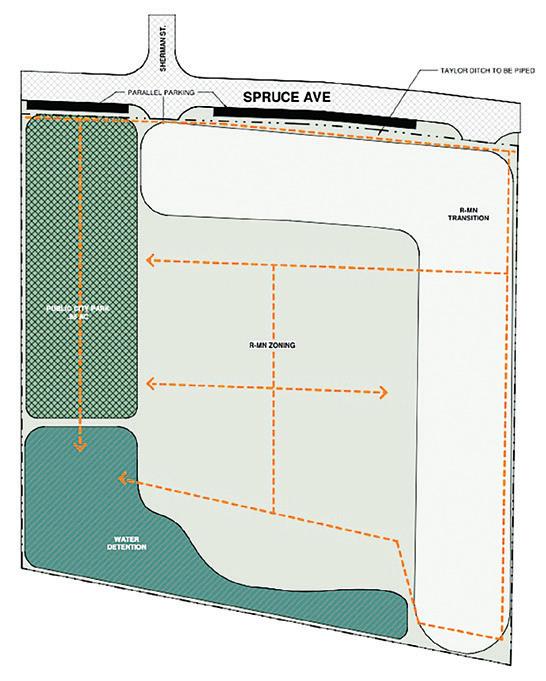
“Whenever you talk constructively, it’s never a loss,” says Ted O’Neill, a participant who favors lower density, adding that he was encouraged by participation from the lead developer, Mark Young, and his team. “Showing good faith is really key in this because there’s so much suspicion and criticism. It’s so much easier to criticize than to be positive.”
After a nearly six-hour meeting on Aug. 23, Longmont’s Planning and Zoning Commission voted to recommend the approval of the developer’s concept plan to City Council. The concept plan allows for up to 70 units the same number as the originally submitted concept — with an added transition zone of two-story single family and duplex units along the northern and eastern bounds of the property, which developers say will likely limit the total number of units.
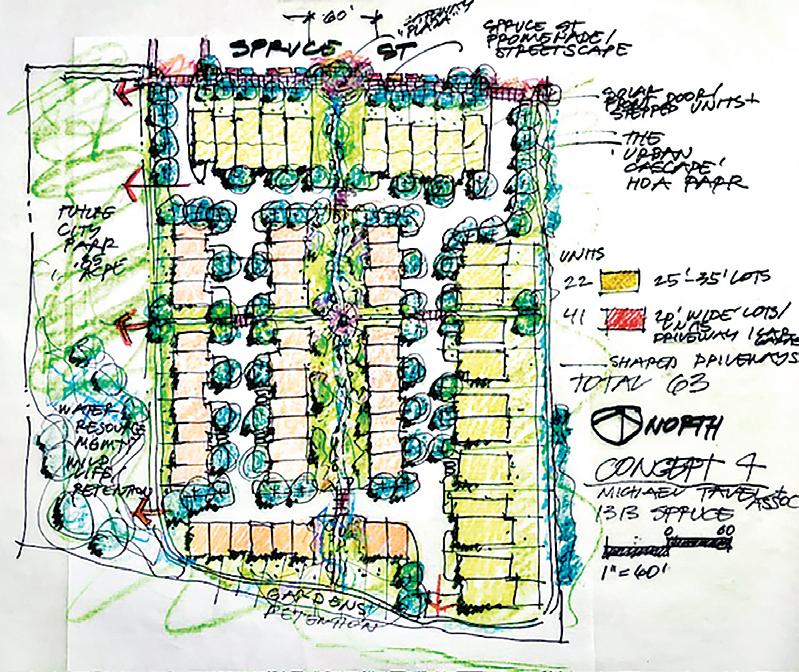
Shakeel Dalal, a Bohn Farm resident who favors higher-density development, calls the charrettes “temperature-lowering.” While he ultimately wanted more units, Dalal said during the public comment of the Planning and Zoning meeting that he believes “reaching consensus requires compromise.”
Dunbar, executive director at Colorado State University’s Institute for the Built Environment, has facilitated charrettes for more than 30 years and says he’s had only a few projects “as contentious” as the development at Bohn Farm.
Boulder County is no stranger to development debates; Bohn Farm is
just the latest deeply contentious iteration. In a city where owner-occupied housing averages just under half a million dollars with a population that’s grown by more than 12,000 since 2010, according to census data, it’s hardly surprising that development is a hot-button issue.
Jennifer Hewett-Apperson, Longmont’s principal city planner, says she’s not aware of other projects in the city that have used a community-centered charrette process. She says it’s “prompted a lot of discussion and some good ideas” and could be a good tool for future large-scale projects.
Drew Sorrells, a Bohn Farm neighbor and interior designer, organized the charrettes with her husband. The couple were initially part of the Bohn Farm Neighborhood Group fighting for lower density, and began acting as liaisons between the community group, the developers and industry professionals.
Sorrells says they later decided to work independently of the neighborhood group after learning “things that the neighborhood was fighting for, like lower density, we learned from those professionals it’s not gonna fly because we need more housing, and the City wants more housing.”
“[We] basically decided that the only way we’re going to bring unity in this community was to bring all of us together,” she says. “There’s a sense we’re all kind of checking our egos at the door, we’re going to come in and see if all of us can compromise a little bit.”
The top categories of consensus that emerge from the Post-it note exercise in the charrette include walkability, having the park on the west side, green space and affordability. There’s also

consensus on offering live-work spaces within the neighborhood.

“Here is a non-evasive [exercise] trying to see what the opposites have in common … instead of personalizing the process, we’re trying to make it impersonal and collective,” Sorrells says.

The conceptual site plan favored by charrette participants, which was later presented at the Planning and Zoning meeting, has a park located on the west side of the development to serve the whole neighborhood and a woonerf design that mixes street use, effectively forcing cars to go 5 mph. It creates pockets of play areas for kids and three walking paths throughout the development. As per City regulations, 12% of the development’s approximately 60 units would be affordable. Those units would be mixed throughout the property’s simple pitched-roof architecture — something many charrettes participants agreed fit the character of the neighborhood.
“We did actually come up with a concept … that we can agree on,” O’Neill says. “And that’s something we haven’t had before.”
Young, the Boulder-based developer, said in the Planning and Zoning meeting he liked the group’s plan better than his initial plan. While he’s been involved in charrettes for other developments before, this is his first that’s involved community members.

“I’ve heard from a lot of people in the community and design professionals that there are ways to make the site more inviting and create a more cohesive atmosphere in the community,” Young says. “We’re going to implement those. We’re going to do the best we can to make sure that as we develop the site, we develop it with those ideas in mind.”
Still, some neighbors are unhappy with the charrettes’ outcome and the concept plan.
“I wish I could report to you that this effort was worthwhile. It was not,” said Cheryl Carter-Pierce, a Bohn Farm resident in favor of lower density, during the Planning and Zoning meeting. “We are left with a bad feeling and a loss of trust.”


Carter-Pierce said she was disappointed by the lack of certain stipulations and that the concept plan was submitted before the end of the final charrette.
For Young, the biggest hurdle ahead will be whether the conceptual site plan from the charrette is feasible from an engineering and code perspective. He cited community members’ inexperience and misunderstandings about code and processes as challenges with the charrettes, but says it ultimately allows residents to engage in a process they wouldn’t typically be involved in, making the project “better than it was when we started.”
Geri Boone, a Planning and Zoning commissioner who voted to approve the concept plan, said in the Aug. 23 meeting she was disappointed in members of the neighborhood group who were “not as open.” While the Bohn Farm Neighborhood Group has more than 200 members, only a few attended the charrettes — making it challenging to reach true consensus.
Boone said she thought the charrettes showed “good faith” by the developer.
“The presentation you made tonight is so much more compatible than the prior presentation,” she said. “You can’t have affordability without density. You just can’t.”
The project still has several rounds of approval before construction can begin — and maybe more charrettes. First, it will move to City Council with a reading of the ordinance on Sept. 26, then a public hearing and a vote by Council on Oct. 10. If approved, the plan will go through the preliminary plat process, which requires Planning and Zoning Commission approval, followed by site, public plat and public improvement plans, which require staff review. Young says he hopes construction can begin by early summer 2024, and he’s confident he can change the minds of neighbors who are still wary of the development.
“Time heals all wounds,” he says. “Keep an eye on the project. It’ll surprise them. And when it’s done a couple of years from now, everybody will be happy with it.”
A new pilot project launched by the City of Boulder aims to increase affordable housing stock for middleincome community members.
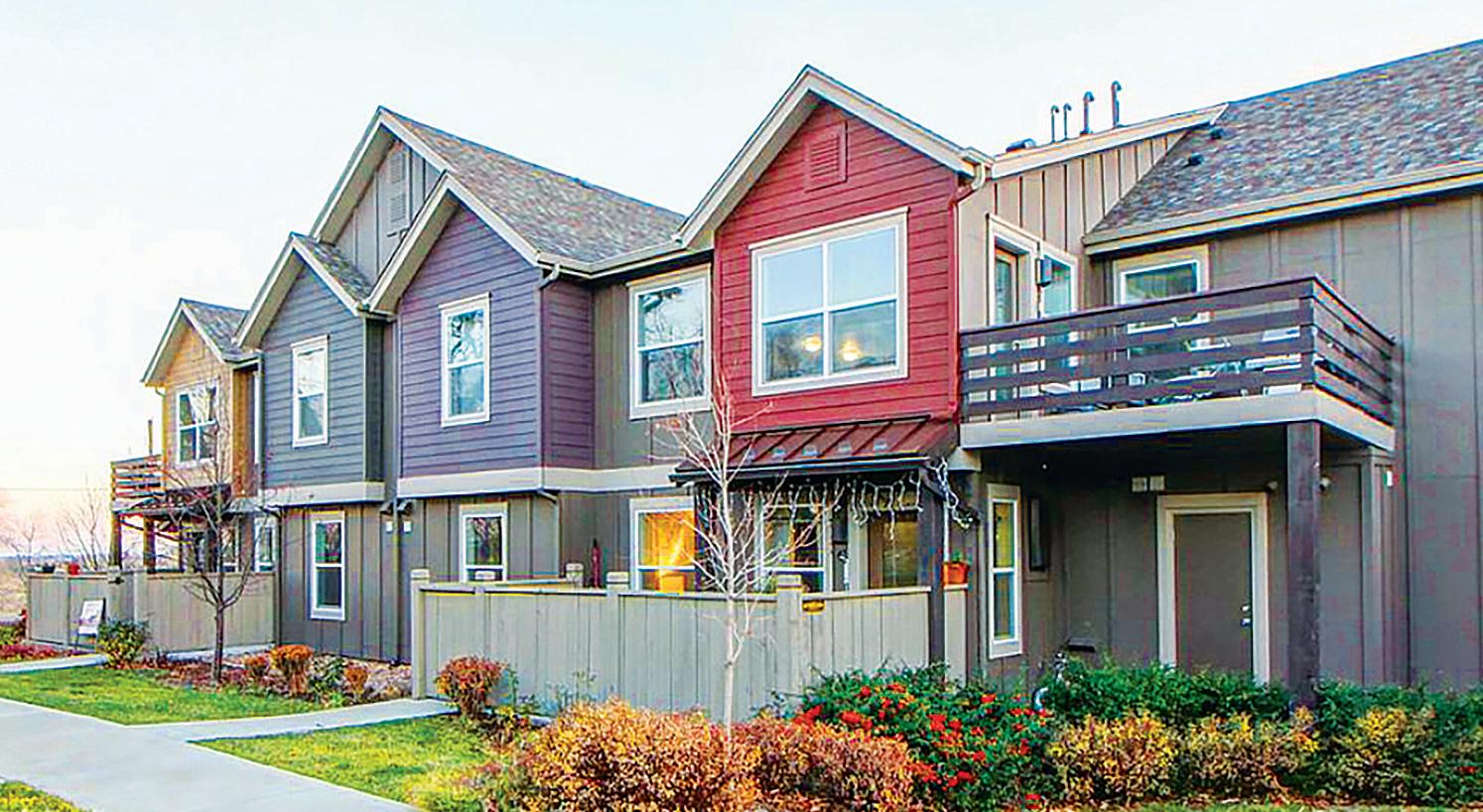
The Middle Income Down Payment Assistance Pilot Program offers a zero-interest second mortgage up to $200,000 or 30% of the home’s sale price, whichever is less, for households with an income limited to 120% of area median income.
“This is an excellent way for middle-income families to purchase a home in Boulder,” said Council member Bob Yates in a press release. “We have folks who work in Boulder, but who can’t afford to have their families live here. The voters overwhelmingly approved this down payment assistance program in 2019. I’m happy that we are finally able to launch the program, so that middleincome families can enjoy the benefits of living in Boulder.”
Applicants must complete the City’s orientation and homebuyer education class, occupy the home
and repay the loan after 15 years. Houses must be market rate, within city limits and a maximum price of $1.3 million for a single-family home and nearly $550,000 for a condo or townhome.
The average home in Boulder is $990,000, according to Zillow. Realtor.com reports a median soldhome price of $1.1 million.
All RTD services will be free for people ages 19 and younger from Sept. 1, 2023 through Aug. 31, 2024.
No tickets are needed — just a valid student or government-issued ID. The yearlong Zero Fare for Youth program was approved after RTD’s most recent fare study and equity analysis recommended the program.
“This pilot program inspires youth to be environmentally minded citizens at a young age — and it builds good transit habits that can be sustained for life,” RTD CEO Debra A. Johnson said in an Aug. 8 press release.
The city is holding community conversation sessions to understand residents’ visions for the nearly 100-year-old Boulder Municipal Airport. The conversation won’t result in a plan, rather a recommendation for City Council, which will then make a decision.
The City has developed four scenarios that illustrate a “highlevel view of possibilities for the future of the airport site” that range from minimal changes to decommissioning and developing a new neighborhood.
There are still hoops to jump through before decisions are made, inpart because the City has to fulfill grant assurances from the Federal Aviation Administration (FAA) for the next 20 years. Because of that, it’s unlikely anything drastic will happen to the airport for years. City staff recently answered questions to help Council consider its options. Here are some of the hotbutton issues.
On leaded fuel: Elimination of leaded aviation fuel seems to be imminent, but there’s still a question of when. The FAA wants to eliminate leaded gas by 2030, but the organization has made it clear that it’s illegal for local airports to ban leaded fuel on their own. The Environmental Protection Agency (EPA) is currently investigating lead emissions from aircraft, the findings of which will likely turn the FAA’s 2030 elimination goal into a deadline. With this expectation in mind, the City of Boulder anticipates unleaded aviation fuel to arrive at the airport within five years.
According to the FAA, more than 222,000 registered piston-engine aircraft operate on leaded avgas containing tetra-ethyl-lead, which prevents engine damage and is more
than a dollar cheaper per gallon than unleaded aviation fuel.
Aircraft at the Boulder airport mostly use 100 low-lead aviation fuel, but the World Health Organization says there is no known safe level of lead exposure. The City will have to work with the Colorado Department of Public Health, Boulder County Public Health and a consultant to test nearby residents’ lead exposure, a process not yet initiated.
On noise: Restraints on noise are elective through a Voluntary Noise Abatement Program. The City cannot enforce a noise abatement. While the City has no data on community members impacted by noise, it’s common to hear complaints from people living near the airport.
On revenue: All airport revenue, collected from lease payments and fuel sold, return to the airport fund for operations and maintenance.
According to the City, the Boulder airport garners about $800,000 in lease payments and fuel sales annually. That dollar amount does not cover the full cost to operate the airport, so the City is reliant on state and federal grants.
On repurposing the airport: The City has engaged in initial conversations with the FAA about repurposing or decommissioning the airport — the most extreme scenario for the facility. So how does the City proceed if retiring the facility is the best path forward?
First, the City of Boulder must stop accepting Airport Improvement Program Grants (AIP). After that, it must maintain the airport, at its own expense, through the duration of federal obligations from previous grants received. The City has accepted about $12 million in AIP grants over the last 20 years. Two decades after the last accepted AIP, the City would file notice of closure of the airport. The timeline of the following litigation is uncertain.
The City doesn’t have a dollar amount for repaying land purchases to the FAA or grant obligations, which could be necessary for decommissioning the airport. City staff will bring that information to Council in early 2024.
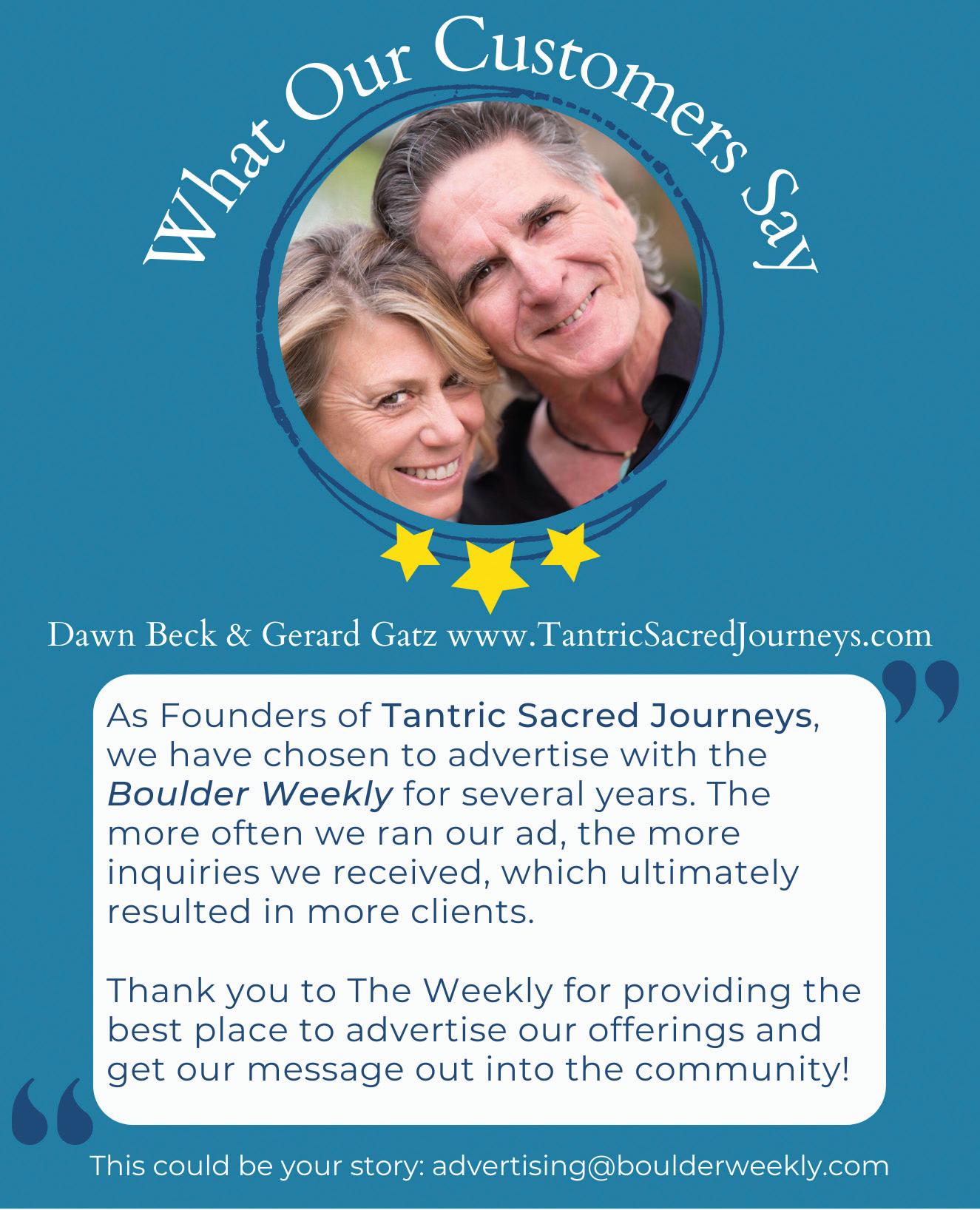
● It’s that time of year: the Buffs are back. And so is the traffic. But we love our collegiate residents. Students started classes on Aug. 28. ’Sko Buffs!
● The first shipment of threatened and endangered Bird Wing butterflies from the Butterfly Pavilion’s (BP) farm in Sumatra, Indonesia, arrived at the Westminster facility last week. It’s the latest in BP’s work to uphold global biodiversity and conservation. Head to butterflies.org to plan a visit to the local insect zoo.

● Boulderites over 18: Register for the city’s second round of e-bike vouchers: bit.ly/eBikeVouchers Applications are open from Aug. 30 to Sept. 13 at 5 p.m. Discounts range from $300 to $1,400 depending on voucher.
● Several Boulder County orgs will receive state grant funding to develop clean energy transportation through the Colorado Electric School Bus Grant Program and the Clean Fleet Vehicle and Technology Grant Program. Recipients in the area include BVSD, CU Boulder, Western Disposal and the City of Boulder.
● Longmont City Council approved a series of ordinances in its Aug. 22 meeting:
○ Increasing the city’s budget for the seventh time for 2023 by appropriating an additional $11 million for six different funds. Longmont’s total 2023 budget is now more than $660.3 million. For comparison, Boulder’s 2023 budget is $513.5 million.
○ A ballot issue dealing with funding an arts and entertainment center.
○ Another ballot issue about financing city libraries, including a new branch.
○ And a third ballot issue focused on capitalization for construction of a recreation center at Dry Creek Community Park and affordable housing in partnership with the YMCA.
● The Longmont Green Party is hosting a meeting to strategize securing livable wages for Colorado workers.
○ Economic Justice Call to Action. Sat. Sept., 2, 3-4 p.m.
○ RSVP at longmontgreenparty@gmail.com

● Kids ages 3-12 living within the city limits of Longmont are eligible for free swim lessons through the City’s recreation services. The program is sponsoring 200 beginner sessions. Applications are processed on a first-come, first-serve basis through December 2023.
○ Apply: bit.ly/LongmontSwimLessons
There’s something for everyone in Boulder Canyon.
Starting just minutes from downtown, each curve in the road that winds through the gorge opens on an arresting landscape of dark pines and lichen-streaked rock that beckon outdoor enthusiasts looking to hike, bike and highline.
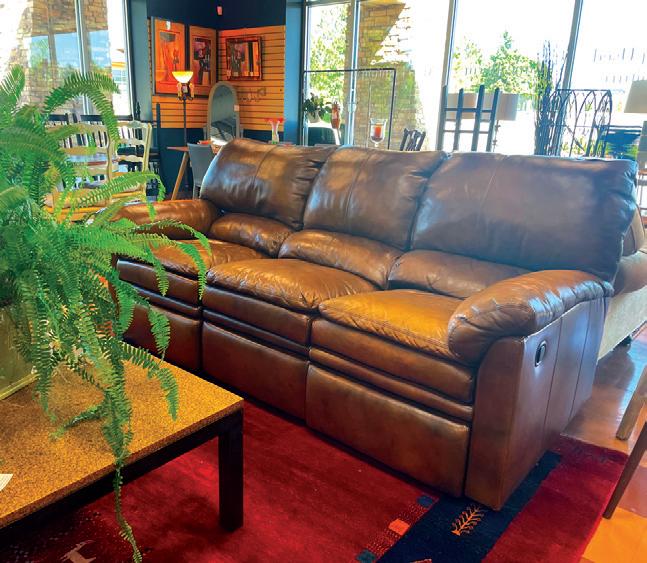
But climbing is perhaps the most popular activity along the 17 miles of road that twist through the canyon. Nearly 2,500 routes dot the ravine’s granite walls, featuring a variety of climbing styles for beginners, shredders and all the chalked-up rock-folk in between.
Some say the canyon has a reputation for soft grades and busy crags. They might be right, especially on cool weekend mornings in the fall.
But Chris Weidner, co-author of the canyon’s most comprehensive guidebook to date, Boulder Canyon, writes that “when it comes to quality, quantity and accessibility, Boulder Canyon has it all.”
It’s not just a local haunt either. Routes like Vicery, Verve, Limits of Power and Gagger have received international attention. Short approach-


es and proximity to the swelling Front Range make the canyon one of the most popular areas to climb in the state.
The untamed crags and elusive features of this gorgeous gully began to capture hearts and minds across the country in the ’90s when sport climbing — clipping into pre-fixed bolts — started gaining popularity. Until then, most routes were traditional — trad, as they say — where climbers place protection equipment on the way up, necessitating more technique, knowledge and gear.
There are many routesetters who deserve kudos for developing climbing through the canyon. Along with fellow trailblazers like Richard Rossiter and Bob D’Antonio, Mark Rolofson saw the ravine’s potential for sport climbing as the style gained popularity across the country.
“Sport climbing was more about pushing yourself and pushing your own limits,” Rolofson says. “The whole
thing was … to look at the line and go, ‘Is this actually possible? Can I climb this?’”
Now 64 years old, Rolofson has established hundreds of routes in Boulder Canyon and written five guidebooks. Many of his routes helped establish the culture and layout of the canyon that so many climbers enjoy today.
People traveled through Boulder Canyon well before climbers dangled on its steep faces.
The first road up the gorge was built in 1868 to meet the demand of the
1940s, someone shimmied up the Third to paint “CU” in 100-foot letters that can still be faintly seen today.

Adventure seekers turned to trad climbing in the canyon around the mid20th century, just before Rolofson started sending pitches as a young man. He grew up in Colorado Springs, where climbing was more developed than in Boulder at the time.
“From a young age, I was really kind of drawn to climbing. That was something I wanted to pursue in life,” he says. “It just fascinated me, the whole climbing thing. It was something I had to do. And it was something that I couldn’t just forget about.”
But as Rolofson was falling in love with climbing in the ‘60s and ‘70s, he says Boulder had a reputation of being “climbed out.” Many of the cracks and flakes essential for placing trad gear were already on established routes.
flourishing mining industry. The toll was $1 for a wagon, and 25 cents to giddyup the road on a horse.
But as Boulder developed, so did climbing. The first recorded rock climb in Colorado was in Boulder in 1906 with an ascent of the Third Flatiron. In the
Despite that, his attention turned to Boulder Canyon in the early ’80s as he put up trad routes like Comfortably Numb (’82). During that time he also got a first ascent on Razor Hein Stick (’85), a slab climb Rolofson called “unclimable” until sticky rubber shoes were introduced.
Boulder quickly joined the sportclimbing movement that swept the country in the late ’80s as battery-powered hammer drills made it easier and faster to put in safer bolts. Rolofson

liked sport climbing because it opened up a lot of new terrain. Before bolted routes, he says many crags had few or no climbs.
He says his establishment of Vasodilator in 1993, renowned as one of the premiere routes on the Front Range known for its multiple overhung cruxes and a smooth arête called “The Egg” at the anchors, marked the beginning of his development of sport climbs in the canyon.
“I was looking for the real striking lines that were available,” he says.
Dianne Dallin, one of Rolofson’s past climbing partners, says when she started climbing in the canyon in the mid-’80s and ’90s you had to “get your game on” and climb harder routes, the only ones available at the time. Sport climbing helped bring lower grades to the canyon and a higher level of security.

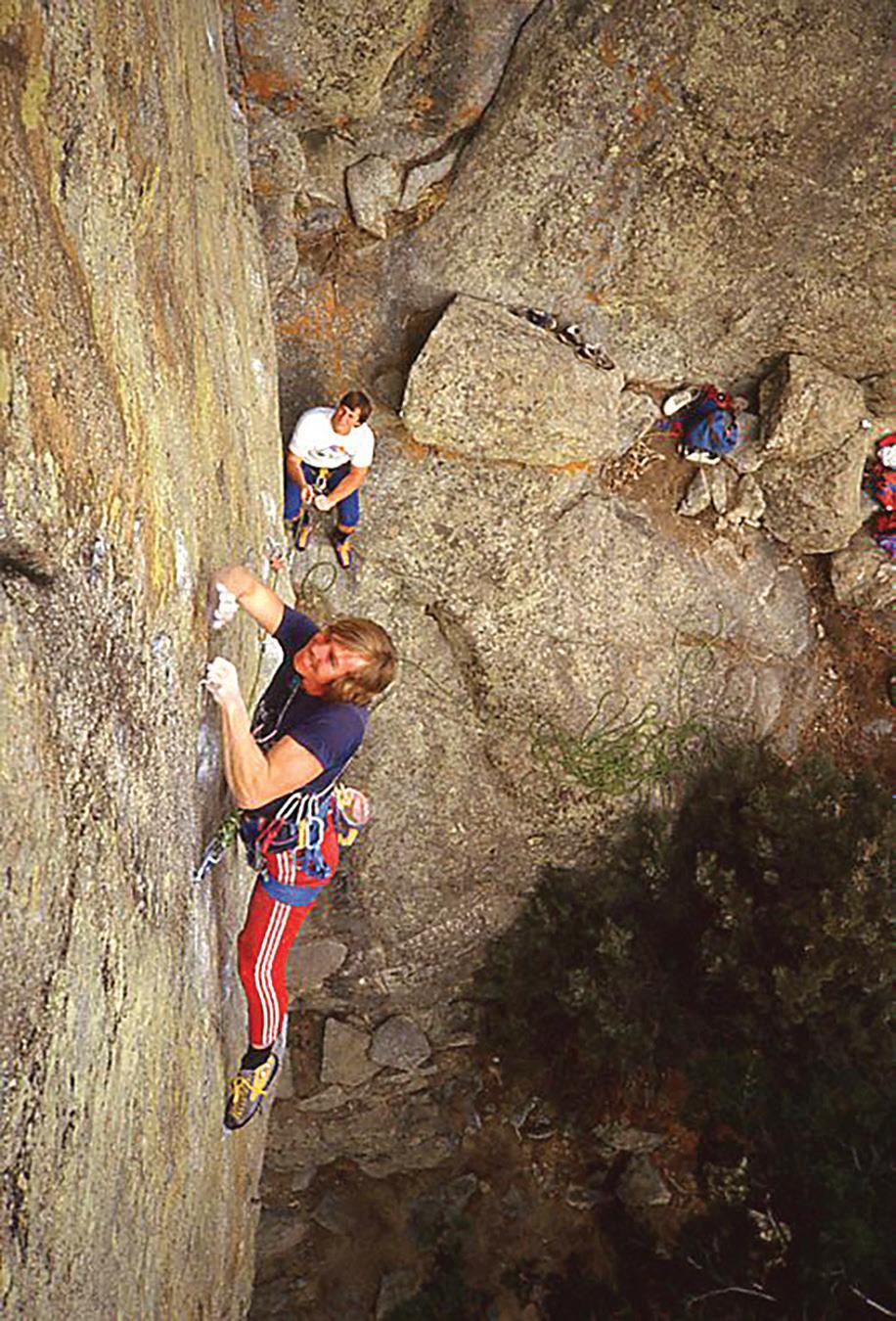
“Sport climbing allows you to put aside a lot of the dangers — but [some are] still there — and just get into, ‘Can I figure this problem out? Can I get my body to do this in the most efficient way?’” she says.
That’s not to say everyone wanted the canyon bolted.
Dallin spoke about tempers flaring at meetings between climbers, bolts getting “chopped” off sport routes and even a restraining order issued on an unnamed climber. But she says Rolofson was an advocate for sport climbing at a time when it was controversial in the local climbing community.
In a 2000 article in The Denver Post, climber and artist Steve Dieckhoff, who
died in 2009, admitted to removing bolts, citing controversy over climbing techniques.
Rolofson didn’t want to get into details of the “bolting wars,” but told Boulder Weekly “a lot happened and quite a bit of it was not positive.”
While bolting remains a focus of debate in climbing ethics today, especially surrounding fixed anchors in the wilderness, the two styles of climbing co-exist.
Routes are still being established in Boulder Canyon.


Jimmie Redo has been climbing around Boulder since the mid-’90s and is a climbing instructor at Movement Boulder. A few years ago he teamed up with professional climber Jon Cardwell and bolted Speaks For the Trees Redo says the obnoxiously challenging route (5.14c) might be the most continuously long and overhung route in the canyon.
“It’s pretty bloody rad,” he says. “It’s like the king line in the canyon.”
It goes to show that even with busy crowds and developed crags, there are still more routes to find.
“The canyon somehow keeps giving in the last few years, routes still keep going up,” Redo says.
Rolofson takes pride in his contributions to climbing in Boulder Canyon

through helping establish classic routes like the Young and the Rackless, The Flying Beast, The Juice and Ecstasy of The People. But for him, it’s always been about quality over quantity.

Climbing is a sport surrounded by a strong ethic. The way you send or establish a route matters, not just for safety but also for integrity. Establishing routes and first ascents are achievements climbers hang their hats on.
“Being first is a big draw,” Redo says. “No one really remembers who won the National Boulder Competition in 2022. But you put up a first ascent, that’s there forever.”
FRIDAY, SEPTEMBER 15 | 7:30 PM

Stories of success, challenge, and advocacy, featuring Tommy Caldwell, Caroline Gleich, Dr. Len Necefer, and Clare Gallagher. Hosted by Sasha DiGiulian.

SATURDAY, SEPTEMBER 23 | 7:30 PM




Experience an evening of contemporary dance with works by Amy Seiwert, Caili Quan, Sarah Tallman, and Ben NeedhamWood.


 BY AARON IRONS
BY AARON IRONS
He may be one of this decade’s leading roots music artists, but Gregory Alan Isakov keeps one foot in the past. On his new album Appaloosa Bones, the celebrated Boulder singer-songwriter fills pop-up boom towns and misty villages with characters as at home in last night’s neon as they may have been in the moonlight 150 years ago.
“A lot of my writing has these characters, this world where I write from where the land is a living thing and all of these elements are living things,” the South Africa-born artist says of the anticipated follow-up to his dreamy 2018 LP Evening Machines
But Isakov’s latest offering benefits from a lot more than nostalgia.
Produced by Andrew Berlin and featuring guest shots from Grammy Awardwinner Aoife O’Donovan and longtime collaborator Bonnie Paine of fellow locals Elephant Revival, Appaloosa Bones generates its kinetic energy with waves of rolling keys and tender acoustic guitar tones filtered through the perspective of one of the region’s most treasured songwriters.
“Every time, I’m like, ‘I’m gonna make this kind of record,’ or I’ll hear a record that’s so inspiring, and I’ll be like, ‘Yes, I wanna make a record in that vein,’ and then the songs just tell you what to do,” he says. “And they’re like, ‘Fuck you, I don’t care what you think. Now, we’re gonna make a super sleepy B-side record and you don’t have any say in it.’”
Recorded at Isakov’s home studio on his Starling Farm east of Boulder, Appaloosa Bones — named after the Appaloosa Grill on Denver’s 16th Street Mall, where he cut his teeth as a performer — features songs decades in the making that were simply waiting to find a home. But Isakov says the craft of songwriting is about more
than reaching a baseline level of proficiency and collecting the music as it comes.
“It’s not like you write a great song that works and now you’re good at it, and now you can write another song,” says Isakov, eight albums deep into a career spanning two decades. “You’re always trip reset every time — and that’s what I love about it. Time’s elusive, and what you think is great, a little bit of time sitting on it will tell you the truth.”
The truth took its time on Appaloosa Bones. Take, for instance, “Before The Sun,” a banjo-driven number that stretches back to Isakov’s early 20s. Like many of its siblings on his new LP, the song gestated for a number of years before he finally blew off the dust and dragged it into the light.

those, and [‘Before The Sun’] is one of the ones that made it. It was that gauge … ‘Do I still feel something? Oh, yeah — yeah, I do.’”
But the 11 tracks on Appaloosa Bones owe their existence to more than simple longevity. As the equine album title suggests, the inspiration for many came from Isakov’s passion for agriculture and animal husbandry. The story of vulnerability and unrequited love told in album closer “Feed Your Horses,” for example, grew out of his time spent caring for alt-country star Brandi Carlile’s horses while the two worked on Isakov’s 2009 classic This Empty Northern Hemisphere.
local origins. The song itself evokes the sepia tones of an Appalachian murder ballad, but its roots trace back to a coyote problem on the artist’s Boulder County farmstead. And in true Isakov fashion, these homespun details give way to a profound life lesson greater than the sum of its parts.
“I changed the oil on [those songs] and took out the high school journal vibes, but I really wanted to honor some of the songs I just play all the time for myself,” he says. “I didn’t know if anyone was going to like it, but I wanted to just really take a look at all
“I was like, ‘That’s such a country song,’” Isakov says of his time tending to the animals on Carlile’s Washington property while she handled press for her landmark album The Story. “I was in her barn with a bunch of old guitars, and I was like, ‘OK, yeah. That’s what I’m doing today.’”
Of course, that on-the-farm sensibility can also be found a bit closer to home. Standout track “Watchman” is one such work, spinning a tragic love story from
“I would just sit up all night with a flashlight on the really bad nights because we kept losing lambs. … I wrote that in the middle of the night, just sitting up listening to coyotes and running out there with this really heavy-duty flashlight,” he says. “I think a lot of that made it into the song, but it turned out to be a song about how we’re always trying to fix things — relationships, systems, everything — and sometimes things that are broken end up perfect.”
ON THE BILL: Gregory Alan Isakov with special guests. Sept. 2-4, Mission Ballroom (Denver), Dillon Amphitheater and Red Rocks Amphitheatre (Morrison). Sold out / resale only.





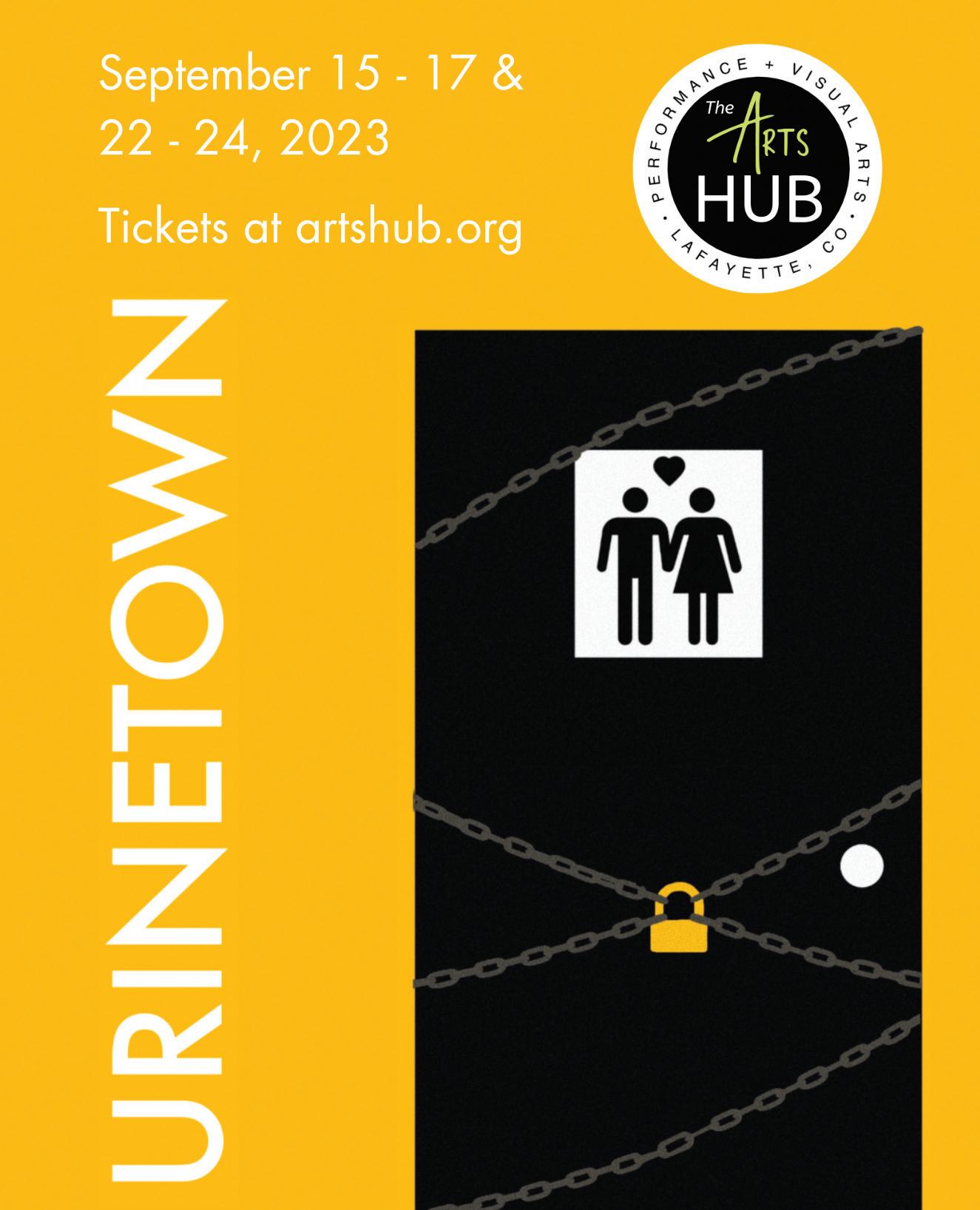

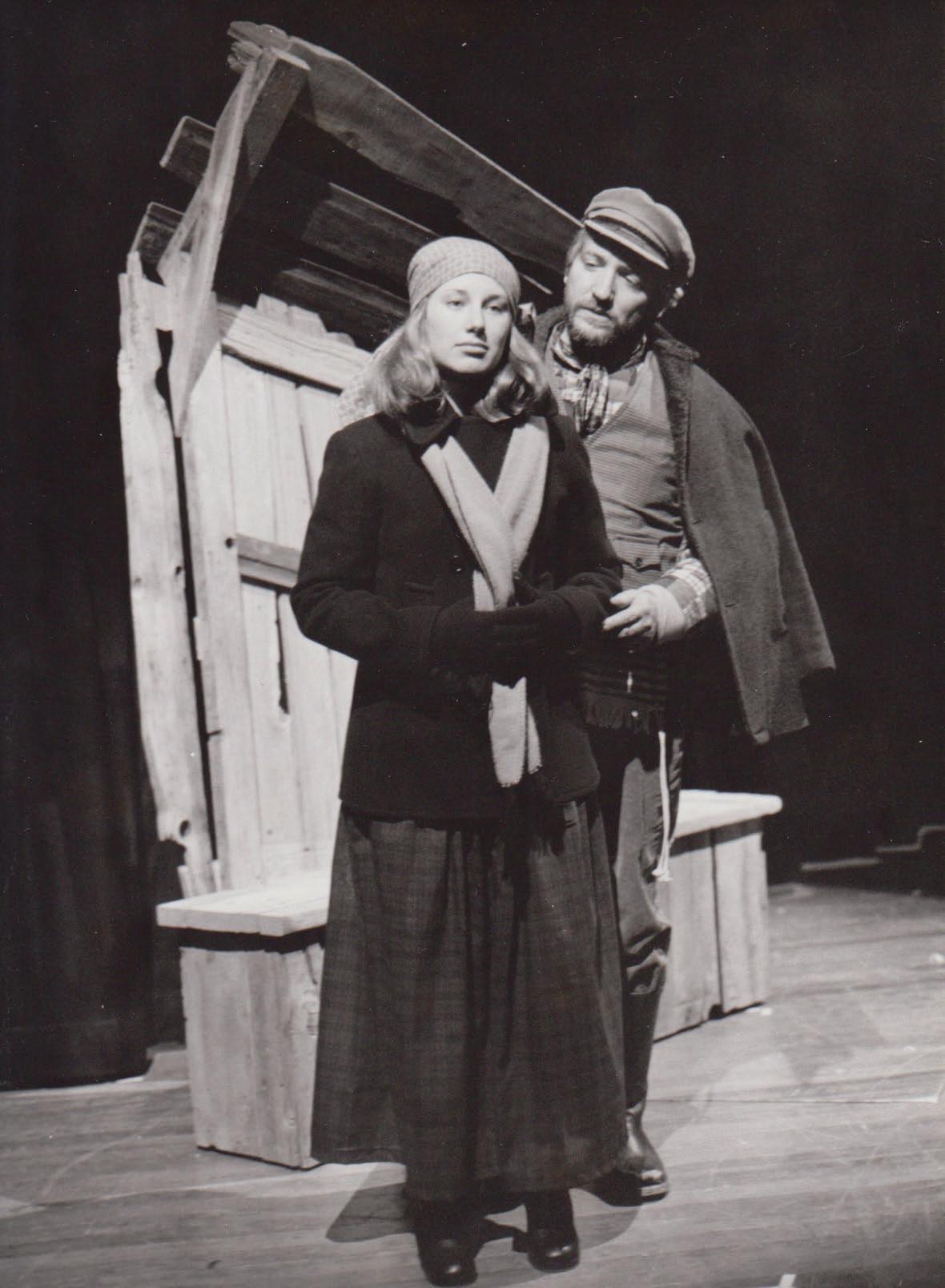





Directing BDT Stage’s final production is a poignant homecoming for Kenny Moten. Over two decades ago, as a freshman at CU Boulder, Moten immersed himself in the local institution, managing sound and reservations.

So when Seamus McDonough, BDT’s producing artistic director, asked if Moten would take the helm of Fiddler on the Roof for the dinner theater’s final offering, emotions ran high.
“Because I had learned a lot in the building,” says Moten, who, since his days running the sound board at BDT, has become a highly in-demand director across the Front Range. “I immediately thought: A.) Yes, and B.) How do we honor Fiddler and BDT?”
Moten says the first thing he and the design team talked about was how they want the audience to feel in the space, “to really honor the building,” which was sold to real estate development firm Quad Capital Partners last summer after crowdsourcing attempts failed to raise enough money.
This will be BDT Stage’s seventh production of Fiddler on the Roof, making it the company’s mostproduced show and a strong choice for an emotional farewell. But originally it was The Sound of Music — the company’s most-requested show — that was slated to close out BDT’s nearly 50-year run before the property’s new owner gave the theater the go-ahead for one more production.
“Originally, when I was plotting out what would have been our next season, I had just gotten the rights for
Fiddler. Literally, the day after I found out that I got the rights for [the play], I found out we were closing,” McDonough says. “And then, because I know how long [new development in] Boulder takes, I decided to hold onto the rights, and, luckily, we were able to do it as an encore.”
Over the years, Fiddler has become one of BDT’s signature shows, a surefire hit that draws an audience. Nearly 60 years after its debut, theatergoers still flock to the story of a poor milkman guiding his family through racism and corruption in turn-of-the-20th-century Russia.
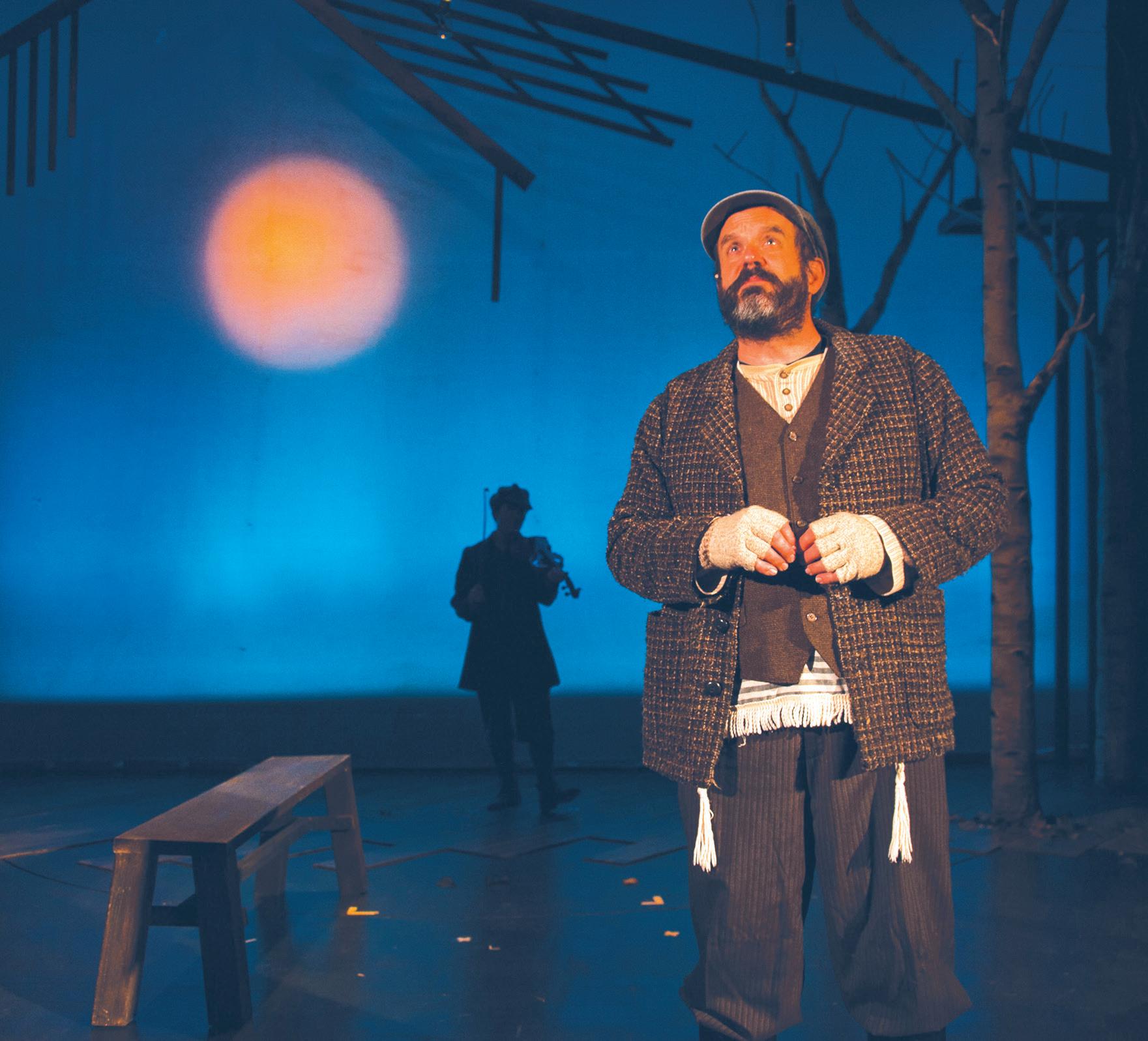
The cast includes a number of BDT veterans, including Wayne Kennedy reprising the role of Tevye for “the fourth or fifth time.”

“It’s such a personal thing for me,” Kennedy says. “The first time I did it in 1999, I was probably a little too young [for the role]. But the next time I played
role of Tevye, Moten anticipates many in the audience will have long-running familiarity with Fiddler. Moten wanted the production for BDT’s staging to be a little darker than what viewers might expect from the Golden Age musical.
“It’s going to look more like what the real world was like for these people,” Moten says. “Making it feel a little more stark and using less color to really drive home where they are and how their lives would be. While there’s such joy in [the story], [the characters] were living a hard life that they were forced into, and there are people in Ukraine right now who are dealing with these same struggles. I don’t want to make a complete downer of a show, but I do want people to understand that this is not an anomaly.”
think it hits us all some days that this is the last thing that’s going to be rehearsed here, and then some days it’s just joyous.”
During the final weeks of the run, the team is inviting dozens of people who have worked with BDT over the years to join in the musical’s large numbers, like “Tradition,” “Sunrise, Sunset,” and “Sabbath Prayer,” in order to include as many company alumni as possible.
Tevye, I had small children, and now they’ve graduated from college. … During [the song] ‘Sunrise, Sunset,’ I’m thinking about my kids and what words of wisdom I can give them. It is also interesting to see how the same exact lines affect me emotionally at different times and places in my life.”
Just as Kennedy grew along with the
The company collaborated with Nancy Lipsey, senior director of programs at Boulder Jewish Community Center (JCC), to guarantee the historical accuracy of customs shown in the musical, like the Jewish wedding scene, and to respond to cast questions.
“Since so many people in the cast have done the show before, the questions they thought to ask led to the most fascinating conversations,” Moten says. But great conversations haven’t masked the sad reality: “I
“So many theaters have closed and not been able to have a months-long goodbye,” Moten says. “I’m forever thankful that we get to celebrate before it’s gone. It is easy to take places like this for granted, and after 46 years of serving Boulder, the community will miss BDT. When people leave the show, I hope they’ll seek out where these performers go next and support their local arts organization, because it doesn’t stop with BDT. All of these artists will still do this work somewhere else, and we need to get out and see it.”


We love our local culture scene here in Boulder County. That’s why we’re bringing you a round-up of goings-on in the world of performing and visual arts, film, music and more. Here’s a snapshot of what’s happening locally, so you don’t have to miss a beat.
Paradise Found expands to the Golden State Boulder’s only music store dedicated exclusively to the sale of new and used albums will soon open a second location in Petaluma, California. Paradise Found Records and Music is set to launch its new Bay Area storefront in early September.
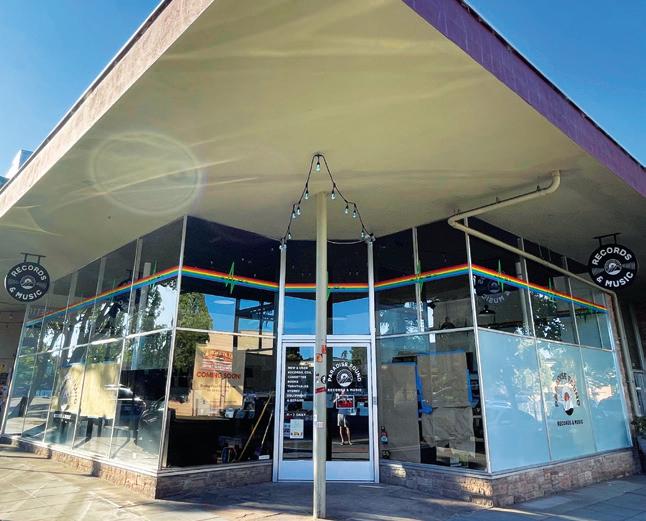
“We went through something like eight or 10 locations, all not working out for whatever reason,” vinyl buyer Patrick Selvage says of the yearlong hunt for the Boulder-born shop’s West Coast digs. “And then we finally found this place, which was perfect.”
The new 1,400-square-foot store in downtown Petaluma is the first expansion for Paradise Found. With sales surging after the pandemic sparked new interest in vinyl, owner Will Paradise — a former Bay Area resident who bought the Boulder store formerly known as Bart’s Record Shop in 2016 — said now is the right time, and crucially, California shop co-owner David Lannon is the right partner.
“I’m thrilled to have the store in Boulder. I don’t need to [open] any more stores,” Paradise says. “But David and I have been friends for so
long, and we both share a passion for music. If it was anybody else, I wouldn’t be doing it.”
After traveling from the Golden State to the Pearl Street shop for Record Store Day events and other regular visits throughout the year, Lannon says running the new location is an opportunity to build on the success of a beloved local brand by bringing it to a new corner of the map.
“We’re anxious to open and recreate that feeling of Paradise Found in Boulder,” Lannon says of the Petaluma store’s imminent launch. “But we understand we have to earn it with each customer every day.”
Longmont Museum launches $8.1 million capital campaign with new director
After more than 25 years with the organization, longtime curator of history Erik Mason has been named the new director of the Longmont Museum. The announcement comes alongside the launch of an $8.1 million capital cam-
paign for the local cultural institution.
“The expansion is about more than bricks and mortar,” Mason said in an Aug. 23 press release. “It’s about making the museum more responsive to our community.”
The fundraising push follows years of community input surrounding the needs of the facility launched in 1940 as a small exhibition space inside the city’s historic Callahan House. Goals include a new children’s gallery along with an expanded primary exhibition room, renovated courtyard and more office space.
The museum has raised 80% of its goal, according to the capital campaign’s website. The project is in its initial permitting phase and the full expansion is estimated to be completed by early 2026. Support the campaign by scanning the QR code associated with this news item.
Boulder Symphony & Music Academy establishes $250,000 endowment with anonymous donation
The sounds just got sweeter at Boulder Symphony & Music Academy (BS&MA), which recently announced the establishment of a $250,000 endowment through an anonymous donation.
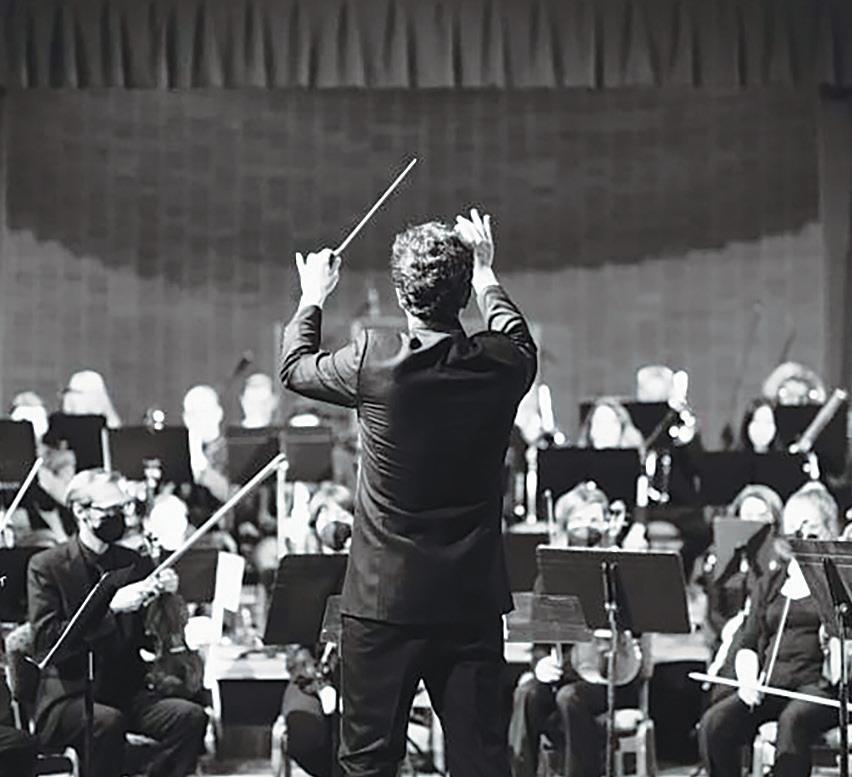
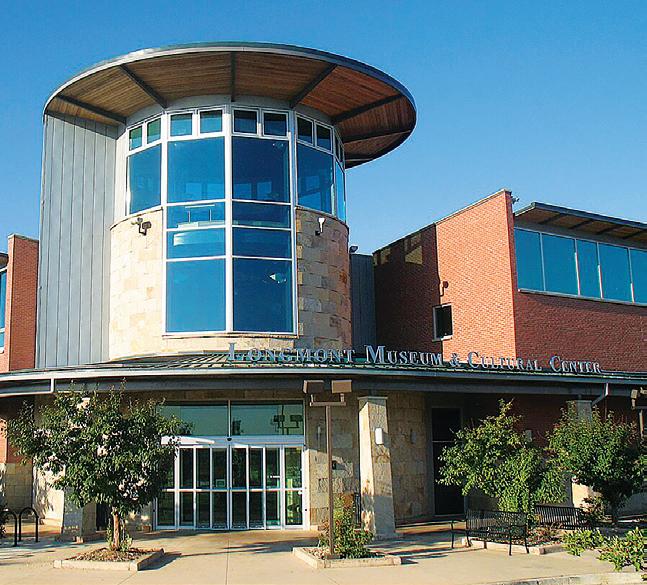
With a goal of increasing contributions to $2 million, the organization hopes to use the endowment to strengthen its educational initiatives and artistic endeavors while providing sustainable support for core operations.
“The anonymous donor’s extraordinary contribution reflects a deep commitment to the arts and recognizes the invaluable role of BS&MA in enriching the cultural landscape of the communi-
ty,” the organization wrote in a July 27 press release. “This endowment will serve as a substantial resource to support the organization’s ongoing efforts in providing exceptional musical education and performances for all.”
In the wake of the devastating 2013 Boulder County floods, a groundswell of community pride and resiliency bolstered the momentum of an outdoor art project in the hard-hit town of Lyons. Now the Lyons Arts and Humanities Commission (LAHC) has announced the addition of 14 new sculptures to the city’s heARTS of LYONS Outdoor Arts Collection Newcomers to the town-wide program include works by Colorado artists Charlotte and Ben Zink, Sue Quinlan, Kevin Shaffer, Steve Buduo (pictured above), Parker McDonald, Justin Deister, Jonathan Corson-Rikert, Kirk Seese, and the late Bill Vielehr. Their installations can be found at locations throughout Lyons, including Main Street, Highway 66, Bohn Park and LaVern M. Johnson Park.
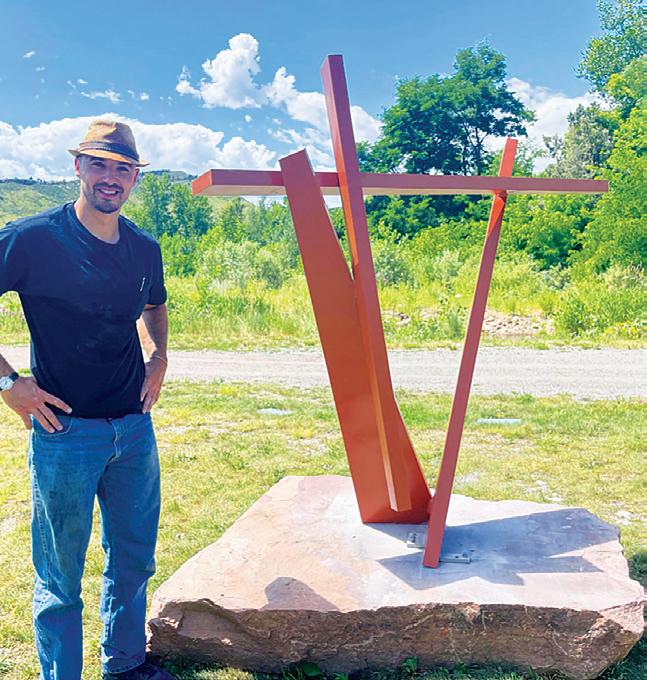
Visit bit.ly/HeartsBW for information regarding LAHC’s 2024 Call for Artists, and scan the accompanying QR code for an interactive map with details about the public works currently on display.
Got local art news? Email BW culture editor Jezy J. Gray at jgray@boulderweekly.com
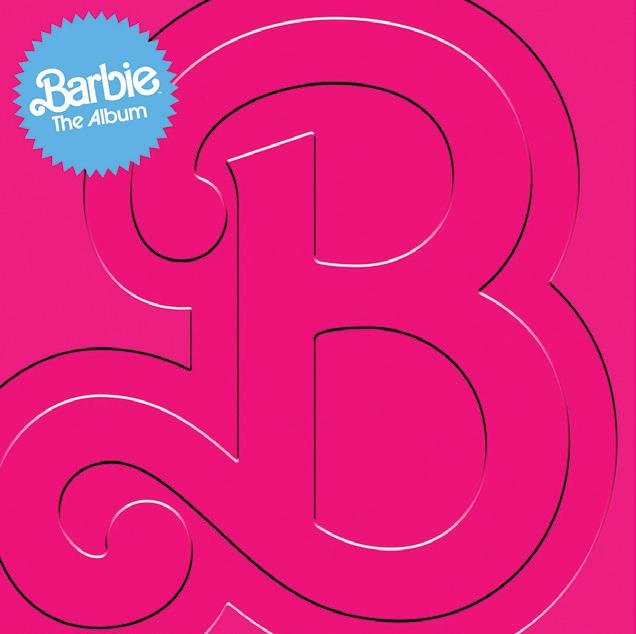
 BY BOULDER WEEKLY STAFF
BY BOULDER WEEKLY STAFF






It’s been a minute, but we’re back with another roundup of the latest bestsellers at Paradise Found Records and Music (1646 Pearl St., Boulder). This time we’re bringing you the bestsellers of the month. From local boy Gregory Alan Isakov (story on p. 17) to Barbie: The Album, these are the new releases that flew off the shelves in August.
It’s been a little over a year since Philly hardcore heroes Soul Glo released their ferocious full-length Diaspora Problems, but this offthe-wall smattering of sweaty basement punk anthems, glitchy party-rock jams and political noise-hop madness sounds more urgent than ever. Don’t miss my interview with vocalist Pierce Jordan ahead of the band’s Sept. 7 gig with Zulu at Denver’s Marquis Theater in next week’s issue.
— Jezy J. Gray, arts and culture editor
For the complete Top 10, visit bit.ly/FoundSoundsBW

EVERY WEDNESDAY BOULDER BLUEGRASS JAM
FRI. 9/1 - 8:00PM
BACK STABBATH & HOWLIN’ GOATZ
MON. 9/4 - 6:30PM
OPEN MIC WITH STEVE KOPPE
TUE. 9/5 - 7:00PM
SONGCRAFT: SONGWRITER
SHOWCASE WITH CARLOS BARATA & INGRID AVISON
THU. 9/7 - 7:00PM
CLAY ROSE, SINGERSONGWRITER NIGHT WITH SPECIAL GUEST TAYLOR SIMS
FRI. 9/8 - 8:00PM
ROCKET PARADE
SAT. 9/9 - 7:30PM
SETH GLIER
MON. 9/11 - 7:00PM
AMY LEVERE & WILL SEXTON
TUE 9/12 - 8:00PM
BLAIR BORAX, MEGAN BURTT & ALEX DUNN
THU. 9/14 - 8:00PM
ANTONIO LOPEZ BAND & LAURIE DAMERON
SAT. 9/16 - 6:00PM
K9’S, COWBOYS & COCKTAILS FUNDRAISER
TUE. 9/19 - 6:30PM
MOJOMAMMA LIVE BROADCAST ON 88.5 KGNU
SAT. 9/23 - 10:00PM GREEN BUDDHA
THU. 9/28 8:00PM
THE TONY FURTADO ACOUSTIC TRIO FEAT. MATT FLINNER
Purchase Tickets at RMPtix.com RootsMusicProject.org

4747 Pearl Suite V3A

1
MELANIN FUNK FESTIVAL
6-9 p.m. Friday, Sept. 1, 13th Street between Arapahoe and Canyon, Boulder. Free
RESCHEDULED: Celebrate Black culture and community during Melanin Funk Festival, an evening of food, drinks and music in the heart of downtown Boulder. Colorado hip-hop duo The Reminders headline this free event, so be sure to bring your dancing shoes. 1

SANS SOUCI FESTIVAL OF DANCE CINEMA: SEASON

PREMIERE
6:45-9 p.m. Friday, Sept. 1, Museum of Boulder, 2205 Broadway. $32
Come celebrate 20 years of movement on film during the season premiere of the Sans Souci Festival of Dance Cinema. The Museum of Boulder hosts this red-carpet event with VR and video installations, local beer and wine, delectable offerings from T/aco and cutting-edge dance films curated by leading industry professionals.
1
SMASH THE PATRIARCHY
7 p.m.-midnight, Friday, Sept. 1, Junkyard Social Club, 2525 Frontier Ave., Unit A, Boulder. $15-$25
Support transgender youth during the second annual Smash the Patriarchy fundraiser at Junkyard Social Club. This drag show and live music event features performances by Weird Al Spankabitch, Miss Fortune and more, plus car-smashing and stiletto darts. 1
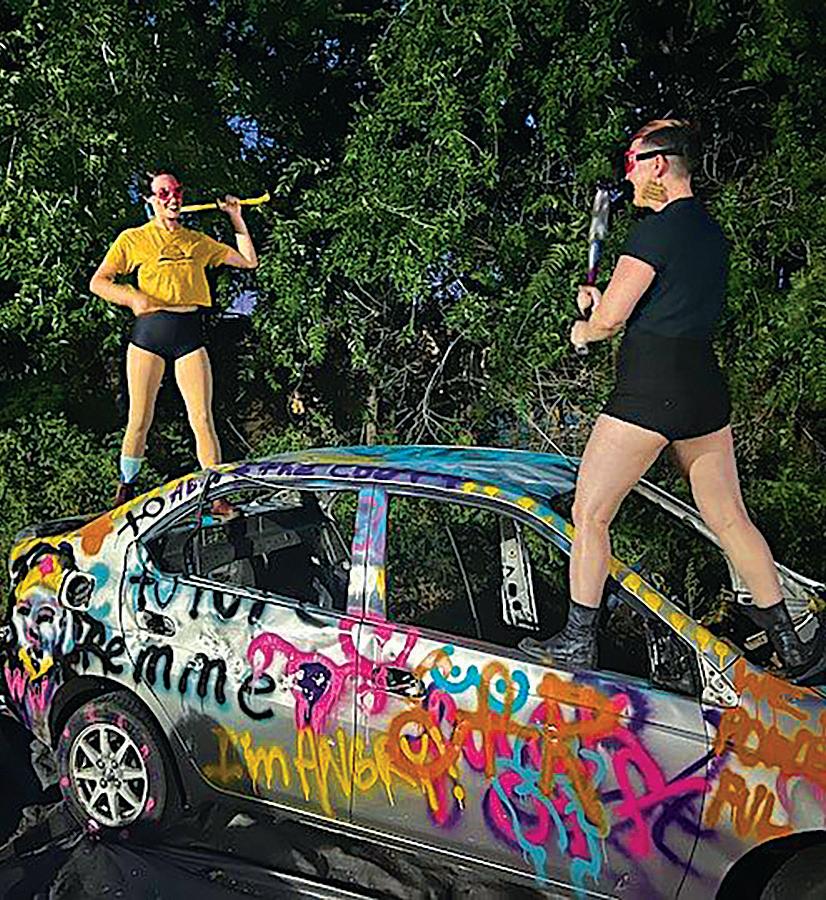
IMPROV @ THE SPARK
7-8 p.m. Friday, Sept. 1, The Spark, 4847 Pearl St., Unit B4, Boulder. $5
“Yes, and…” is the name of the game during this gut-busting improv showcase at The Spark in Boulder. Hilarious teams from The Improv Collaborative will perform short-form games and longer scenes based on audience suggestions during this onenight event on Pearl Street.
1-10
LOUISVILLE ART ASSOCIATION SHOW AND SALE
10 a.m.-6 p.m. Sept. 1-10, Louisville Center for the Arts, 801 Grant Ave. Free

The Louisville Art Association hosts the 38th Annual National Juried Fine Art Show and Sale during an eightday event at the Louisville Center for the Arts. 100 works have been selected for the juried show that’s been a crucial part of the East County art scene for more than three decades.
2LEGO CLUB
2-3 p.m. Saturday, Sept. 2, Erie Community Library, 400 Powers St., Erie. Free
Got a little LEGO maniac in your life? They can “dream it, build it and make friends” during the LEGO Club at Erie Community Library. This fun-forward day of creativity is open to kids ages 6-13 who can build independently. Limited to the first 20 children signed in by an adult.

4-8 p.m. Saturday, Sept. 2, Louisville Community Park, 955 Bella Vista Drive. $10-$45
Head to Louisville Community Park for an afternoon of craft brews, food vendors and live music. Whether you’re a devoted hop head, adventurous foodie or you’re just looking to enjoy a fun day in the sunshine, you won’t want to miss this community event presented by the Louisville Chamber of Commerce.

5-7 p.m. Sunday, Sept. 3, The New Local, 741 Pearl St. $55
Oracle cards will light the way home during this free-writing event at The New Local on Pearl Street. Express yourself and connect with your spirit through a guided session and writing workshop designed “to articulate whatever hurts and whatever enlivens.”

RC

1-6 p.m. Sunday, Sept. 3, Left Hand Brewing, 1265 Boston Ave., Longmont. Free
Mini-trucks, start your engines! Rumble over to the garden at Left Hand Brewing in Longmont to obliterate the Sunday scaries with the RC Monster Truck Challenge. Two trucks per class limit (open, sport, pro-mod, retro and freestyle). No nitro vehicles. Scale and battery limits apply.
7-9 p.m. Tuesday, Sept. 5, R Gallery + Wine Bar, 2027 Broadway, Boulder. Free


Calling all shutterbugs! Boulder-based photographer and R Gallery + Wine Bar owner Rob Lantz hosts this monthly night of art and community centered around the art of photography. Present your work and connect with fellow artists during this NoBo networking event complete with craft beer and wine.

6:30-8:30 p.m. Tuesday, Sept. 5, Junkyard Social Club, 2525 Frontier Ave., Suite A, Boulder. Free
It’s been more than a century since over 230 women, children and elders of the Cheyenne and Arapaho tribes were killed near Colorado’s Fort Lyon in a surprise attack by the United States military. With the scars still lingering, Junkyard Social Club hosts a public dialogue and workshop surrounding the Sand Creek Massacre of 1864.
OKTOBERFEST TAPPING AND PARTY
5-8 p.m. Thursday, Sept. 7, Boulder Social, 1600 38th St. Free

Fall is right around the corner, and for beer lovers that means one thing: Oktoberfest. Join Boulder Social as they tap their seasonal Social Festbier during a lively night with German food, drink specials and music by Matt Flaherty.

Software Test Automation Engineer sought by SomaLogic Operating Co., Inc., dba SomaLogic, in Boulder, CO (may work remotely from anywhere in U.S.) to build, expand & test web appls for storing & managing sci & biomed data. For job details, rqmts & how to apply refer to: https://jobpost. works/3854ek/

Show starts at 7pm NO COVER
JOSH BEIRMAN 6 p.m. BOCO Cider, 1501 Lee Hill Drive, Unit 14, Boulder. Free
TAB BENOIT WITH THE RUMBLE AND CHIEF JOSEPH BOUDREAUX
JR. 8 p.m. Boulder Theater, 2032 14th St. $28
DJ BLAKE BRITTON. 9 p.m. Hi-Dive, 7 S. Broadway, Denver. Free
SUZANNE SANTO. 8 p.m. Globe Hall, 4483 Logan St., Denver. $22
BEN HANNA 9:30 p.m. Velvet Elk Lounge, 2037 13th St., Boulder. Free
REZZ WITH LAB GROUP, SKELER, DIGITAL ETHOS AND REDRUM. 5:30 p.m. Red Rocks Park and Amphitheatre, 18300 W. Alameda Parkway, Morrison. $47
STEVE VIDAIC BAND. 7:30 p.m. The Louisville Underground, 640 Main St. Free
THE CBDS. 6 p.m. BOCO Cider, 1501 Lee Hill Drive, Unit 14, Boulder. Free
TWO PUMP CHUMP WITH TOADSTOOL, DJ IRIS AND SERATO BLISS 9 p.m. Fox Theatre, 1135 13th St., Boulder. $18
BACK STABBATH WITH HOWLIN’ GOATZ. 8 p.m. Roots Music Project, 4747 Pearl St., Suite V3A, Boulder. $12
DANCE MACHINE 7:30 p.m. Nissi’s, 1455 Coal Creek Drive, Unit T, Lafayette. $15
MICHAEL SANTULLI 6 p.m. BOCO Cider, 1501 Lee Hill Drive, Unit 14, Boulder. Free
CHATHAM COUNTY LINE WITH TIFFANY CHRISTOPHER
9 p.m. Velvet Elk Lounge, 2037 13th St., Boulder. $20
No one does it quite like Janelle Monáe. The Grammy-winning music artist and actor comes to Red Rocks on Sept. 7 in support of their fourth LP, The Age of Pleasure — a freewheeling scramble of Afrofuturistic pop, soul and R&B hailed by critics as a high watermark in the career of a shapeshifting cultural icon who refuses to sit still See listing for details

KROOKED KINGS 8 p.m. Fox Theatre, 1135 13th St., Boulder. $20
RISING APPALACHIA WITH PATRICK DETHLEFS. 7:30 p.m. Chautauqua Auditorium, 900 Baseline Road, Boulder. $33
RAJU LAMA (MONGOLIAN HEART)
7 p.m. Boulder County Fairgrounds, 9595 Nelson Road, Longmont. $60
THE CHAINSMOKERS (NIGHT 1). 7:30 p.m. Red Rocks Park and Amphitheatre, 18300 W. Alameda Parkway, Morrison. $160
GREGORY ALAN ISAKOV WITH SHOVELS & ROPE 8 p.m. Mission Ballroom, 4242 Wynkoop St., Denver. $51 Story on p. 17
DECENT CRIMINAL WITH RICKY, TUFF BLUFF AND DJ GLIMMER OF NOPE 9 p.m. Hi-Dive, 7 S. Broadway, Denver. $15
HALFWAY THERE WITH MILE HI INFIDELITY 7:30 p.m. Nissi’s, 1455 Coal Creek Drive, Unit T, Lafayette. $20
SUNDAY, SEPT. 3
DANNY SHAFER 4 p.m. BOCO Cider, 1501 Lee Hill Drive, Unit 14, Boulder. Free
VITALWILD & ZAJE 9 p.m. Velvet Elk Lounge, 2037 13th St., Boulder. Free
THE CHAINSMOKERS (NIGHT 2)
7:30 p.m. Red Rocks Park and Amphitheatre, 18300 W. Alameda Parkway, Morrison. $160
DANCE GAVIN DANCE WITH SIM, RAIN CITY DRIVE AND WITHIN DESTRUCTION. 7 p.m. Mission Ballroom, 4242 Wynkoop St., Denver. $40
MONDAY, SEPT. 4
GREGORY ALAN ISAKOV 7 p.m. Red Rocks Park and Amphitheatre, 18300 W. Alameda Parkway, Morrison. $142
BLUSHING WITH WAVE DECAY AND CALAMITY. 8 p.m. Hi-Dive, 7 S. Broadway, Denver. $15
TUESDAY, SEPT. 5
CARLOS BARATA WITH INGRID AVISON 7 p.m. Roots Music Project, 4747 Pearl St., Suite V3A, Boulder. Free
DIERKS BENTLEY WITH ASHLEY MCBRIDE, RED CLAY STRAYS AND HARPER O’NEILL 7 p.m. Red Rocks Park and Amphitheatre, 18300 W. Alameda Parkway, Morrison. $91
DEAN JOHNSON WITH DEVIN CHAMPLIN AND GEORGE CESSNA. 7:30 p.m. Hi-Dive, 7 S. Broadway, Denver. $15
WEDNESDAY, SEPT. 6
DIERKS BENTLEY WITH THE INFAMOUS STRINGDUSTERS, TANNER USREY AND KAITLIN BUTTS. Red Rocks Park and Amphitheatre, 18300 W. Alameda Parkway, Morrison. $91
GLASSING WITH DEEP CROSS, PSYCHIC KILLERS AND PALEHORSE/ PALERIDER 8 p.m. Hi-Dive, 7 S. Broadway, Denver. $18
THURSDAY, SEPT. 7
CORONA COLLECTIVE. 5 p.m. BOCO Cider, 1501 Lee Hill Drive, Unit 14, Boulder. Free
STILLHOUSE JUNKIES WITH THE WRECKLUNDS 9 p.m. Velvet Elk Lounge, 2037 13th St., Boulder. $14
NOAH CYRUS WITH ANNA BATES. 8 p.m. Boulder Theater, 2032 14th St. $30
JANELLE MONÁE. Red Rocks Park and Amphitheatre, 18300 W. Alameda Parkway, Morrison. $45 BW Pick of the Week
CAITLYN SMITH WITH BRANDON RATCLIFF. 8 p.m. Fox Theatre, 1135 13th St., Boulder. $18
CLAY ROSE WITH TAYLOR SIMS 7 p.m. Roots Music Project, 4747 Pearl St., Suite V3A, Boulder. $20
Want more Boulder County events? Check out the complete listings online by scanning this QR code.
“Beetlejuice, Beetlejuice, Beetlejuice!” The titular character from Tim Burton’s beloved 1988 classic gets the musical theater treatment in Beetlejuice at the Buell Theatre. Don’t miss the Broadway show Variety calls “screamingly good fun,” running at the Denver Performing Arts Complex Sept. 5 through Sept. 17. See listing for details.
Visual artist Micah Bazant creates work “inspired by struggles to decolonize ourselves from white supremacy, patriarchy, ableism, and the gender binary.” Their ongoing exhibition Art of Trans Liberation at Boulder’s East Window Gallery explores concepts of love and solidarity through a power-building framework centered on the fight for trans rights and racial justice. See listing for details
Need a little inspo for your next family vacation? Join authors Annika Paradise, Julie Frieder and Angela Heisten as they discuss and sign their new book Wonder Year: A Guide to Long-Term Family Travel and Worldschooling at Boulder Book Store on Sept. 7. See listing for details

WIZARD OF OZ Unitiive Theatre, 800 S. Hoover St., Longmont. Through Sept. 16. $15
A MIDSUMMER NIGHT’S DREAM Denver Center for the Performing Arts (Kilstrom Theatre), 1101 13th St. Through Sept. 2. $40
FIDDLER ON THE ROOF Sept. 9-Jan.
14, BDT Stage, 5501 Arapahoe Ave., Boulder.
$70 Story on p. 19
SHELBY SHADWELL: EMERGENCY BLANKETS Through Sept. 3, Firehouse Art Center, 667 4th Ave., Longmont. Free
agriCULTURE: ART INSPIRED BY THE LAND. BMoCA, 1750 13th St., Boulder; and The Longmont Museum, 400 Quail Road. Through Oct. 1 (BMoCA) and Jan. 7 (Longmont Museum). $2 / $8
ABSTRACT: COLORS + FORM R Gallery + Wine Bar, 2027 Broadway, Boulder. Through Sept. 10. Free
KINETIC: BILL SNIDER + MICHAEL DERAGISCH Through Sept. 17, Bus Stop Gallery, 4895 Broadway, Boulder. Free
10TH MOUNTAIN DIVISION AT CAMP HALE BY FLINT WHITLOCK.
6:30 p.m. Thursday, Aug. 31, Boulder Book Store, 1107 Pearl St. $5
GONZO CAPITALISM: HOW TO MAKE MONEY IN AN ECONOMY THAT HATES YOU BY CHRIS GUILLEBEAU.
6 p.m. Tuesday, Sept. 4, Tattered Cover, 1991 Wazee St., Suite 100, Denver. Free
BOOK FAIR FOR ADULTS 5-8 p.m. Friday, Sept. 1, The Wandering Jellyfish Bookshop, 198 2nd Ave., Suite 1A, Niwot. Free
MISS RHYTHM: THE LEGEND OF RUTH BROWN. Through Oct. 15, Denver Center for the Performing Arts (Garner Galleria Theatre), 1101 13th St. $46
BEETLEJUICE. Sept. 5-17, Denver Center for the Performing Arts (Buell Theatre), 1350 Curtis St. $35

DESERT RIDER: DREAMING IN MOTION Denver Art Museum, 100 W. 14th Ave. Parkway. Through Sept. 24. $15
ART OF TRANS LIBERATION. Through Sept. 29, East Window Gallery, 4550 Broadway, Suite C-3B2, Boulder. Free (by appointment only) BW Pick of the Week

NO BOUNDARIES: WOMEN TRANSFORMING THE WORLD. Jerry Crail Earth Science & Map Library, 2200 Colorado Ave., Boulder. Through May 2024. Free
RADICAL BY NATURE: THE REVOLUTIONARY LIFE OF ALFRED RUSSEL WALLACE BY JAMES T. COSTA 6:30 p.m. Wednesday, Sept. 6, Boulder
Book Store, 1107 Pearl St. $5
WONDER YEAR: A GUIDE TO LONG-TERM FAMILY TRAVEL AND WORLDSCHOOLING BY ANNIKA PARADISE, JULIE FRIEDER AND ANGELA

HEISTEN 6:30 p.m. Thursday, Sept. 7, Boulder Book Store, 1107 Pearl St. $5
BW Pick of the Week
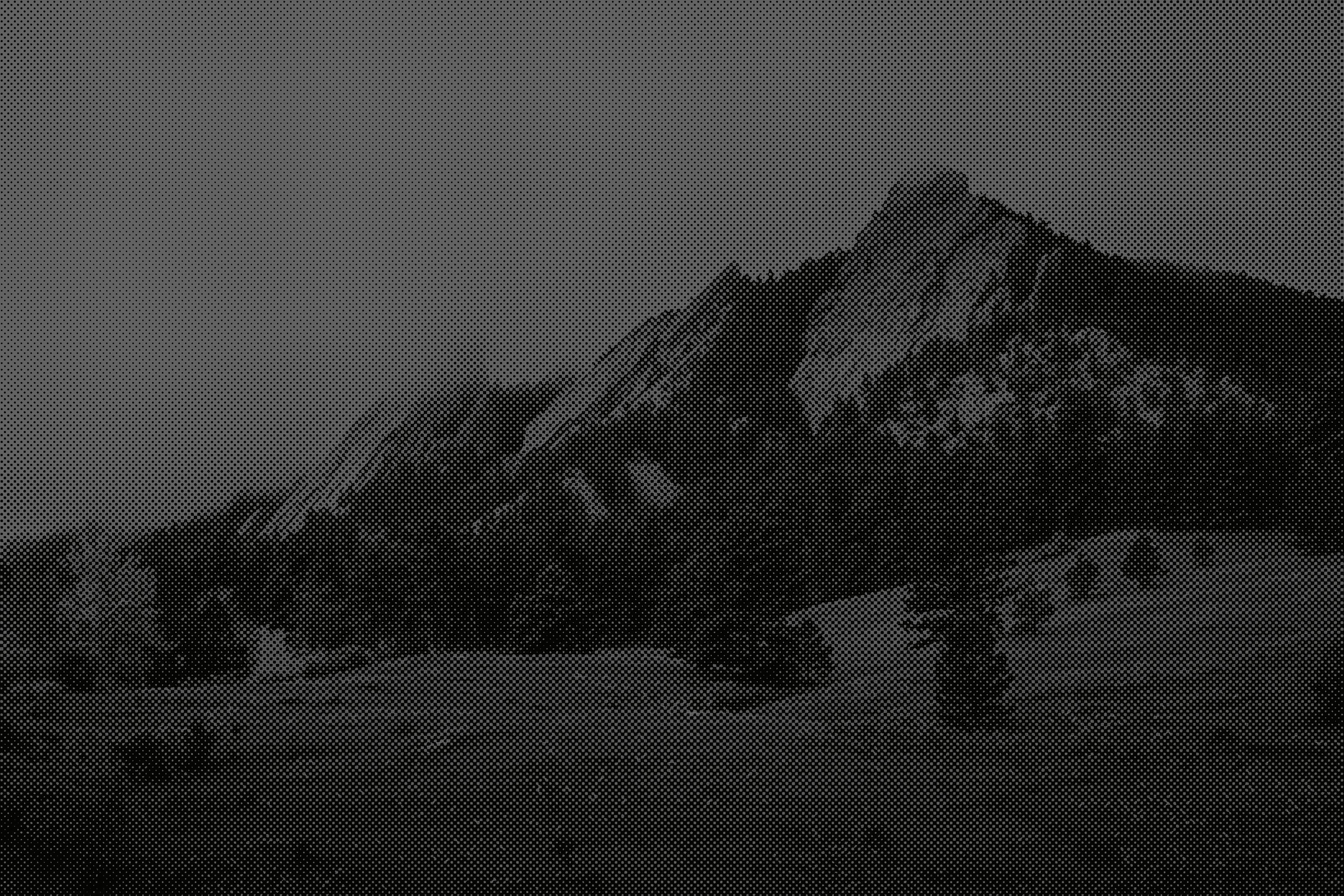
Few figures loom as large in CU’s history as Stan Brakhage. As a filmmaker, his influence on the visual medium is incalculable — even if he’s not commonly known. (Brakhage is to cinema what The Velvet Underground was to rock ’n’ roll.) As a professor, he taught his students to see differently. And not just in images, but in the world around them.

“He successfully pulled his students away from wanting to imitate the patterns of commercial filmmaking, away from just learning to reproduce the effects used in the television and movies they had seen,” says Tony Heiderer, a local appreciator of Brakhage’s work. “Many of his films were not art films in the sense that they are not meant to be beautiful in any traditional way. They were often experimental tests of the human visual system.”
Suranjan Ganguly, professor emeritus in the Department of Cinema Studies and Moving Image Arts at CU Boulder, concurs: “The films are not easy. They’re difficult and challenging.” But Brakhage had a way to cut through that challenge: a weekly salon of screenings and conversations for friends and colleagues. And when Ganguly moved to Boulder to join CU’s faculty in 1991, the pair struck up an immediate friendship and Brakhage invited him to join his weekly gatherings.
The salon “was a very special event in our lives,” Ganguly says. “When Stan died in March 2003, I knew I could not revive that salon ... and without Stan, people wouldn’t show up.”
So Ganguly settled on something else: Celebrating Stan, a monthly 90-minute screening of select Brakhage prints. These screenings, always free and open to the public,
are curated by Ganguly and followed by informal discussion.
Marilyn Brakhage, surviving wife of the late filmmaker, says Celebrating Stan completes the “magic circle” of connection between his work and audiences by facilitating conversation around his singular art.
“It was Stan’s deepest wish that his films would continue to be made readily available,” she says. “And I know he would be deeply moved by Suranjan’s dedicated contribution to this process, as the works continue to be so vitally important for so many.”
For Ganguly, Celebrating Stan is a chance to give back to the “colleague, mentor and best friend” he gained when he joined CU. The series also allows people who love Brakhage’s work to gather and watch, and for professors to introduce new students to the films.
“I tell them that they have one of the rarest opportunities in the world — they can see Stan Brakhage’s films projected on 16 mm for free,” senior instructor emeritus Don Yannacito says. “Some students have had lifechanging epiphanies at some of Suranjan’s screenings.”
And Yannacito isn’t the only one who invokes a spirituality for those who frequented Brakhage’s salons and Celebrating Stan
“Stan often said that he wanted the salons to be something like going to church, there every Sunday for the faithful,” says Bruce Kindel, who attended Brakhage’s gatherings throughout the 1990s. After the launch of Celebrating Stan five months after Brakhage’s passing, he puts it plainly: “Church was back.”
“I’ve been religiously attending,” Brakhage’s longtime friend Carmen Vigil says of the series. “I’m having a much different relationship with his films now that he is not around ... I’m so happy to be able to see his films, and I’m so happy Suranjan has given us all this opportunity.”
Daughter Crystal Brakhage echoes the sentiment: “For Suranjan to ensure the continuation of sharing Stan’s collection and supporting the ongoing audience of filmmakers and poets and visionaries and curious students of all ages, [that] is a legacy in itself.”
And for 20 years now, that legacy has had consistent attendance. Ganguly has rarely had to cancel — even when Oscar night and Super Bowl Sunday roll around, or there are two feet of snow on the ground.
“The Brakhage show goes on,” Ganguly says. “I don’t know how long we can continue, but we hope to continue as long as possible.”
ON SCREEN: Celebrating
Stan. Sundays Sept. 3, Oct. 1, Nov. 5 and Dec. 3, 7:30 p.m. Atlas 100, CU Boulder. Free


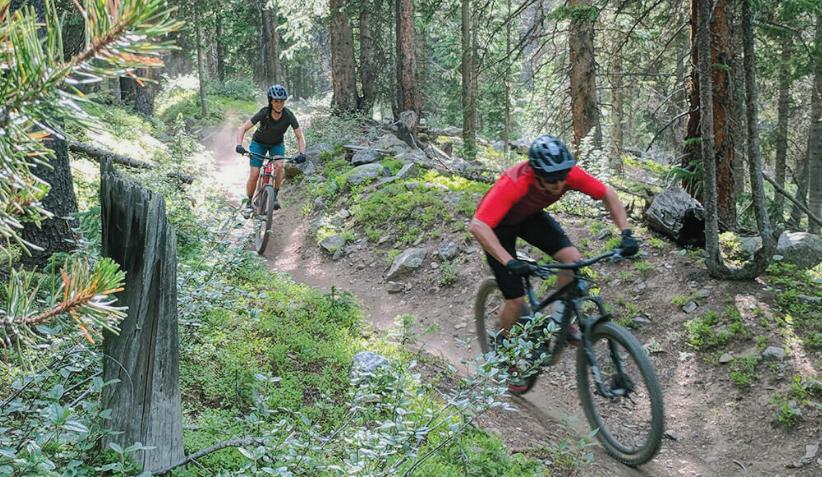
ARIES (MARCH 21-APRIL 19): Climate change is dramatically altering the Earth. People born today will experience three times as many floods and droughts as someone born in 1960, as well as seven times more heat waves. In urgent efforts to find a cure, scientists are generating outlandish proposals: planting mechanical trees, creating undersea walls to protect melting glaciers from warm ocean water, dimming the sun with airborne calcium carbonate, and covering Arctic ice with a layer of glass. In this spirit, I encourage you to incite unruly and even unorthodox brainstorms to solve your personal dilemmas. Be wildly inventive and creative.
TAURUS (APRIL 20-MAY 20): “When love is not madness, it is not love,” wrote Spanish author Pedro Calderon de la Barca. In my opinion, that’s naive, melodramatic nonsense! I will forgive him for his ignorance, since he worked as a soldier and celibate priest in the 17th century. The truth is that yes, love should have a touch of madness. But when it has more than a touch, it’s usually a fake kind of love: rooted in misunderstanding, immaturity, selfishness, and lack of emotional intelligence. In accordance with astrological factors, I assign you Tauruses to be dynamic practitioners of genuine togetherness in the coming months: with hints of madness and wildness, yes, but mostly big helpings of mutual respect, smart compassion, tender care, and a knack for dealing maturely with disagreements.
GEMINI (MAY 21-JUNE 20): Gemini author
Iain S. Thomas writes, “There are two things everyone has. One is The Great Sadness and the other is How Weird I Really Am. But only some of us are brave enough to talk about them.” The coming weeks will be a favorable time to ripen your relationship with these two things, Gemini. You will have the extra gravitas necessary to understand how vital they are to your full humanity. You can also express and discuss them in meaningful ways with the people you trust.
CANCER (JUNE 21-JULY 22): A self-fulfilling prophecy happens when the expectations we embrace actually come to pass. We cling so devotedly to a belief about what will occur that we help generate its literal manifestation. This can be unfortunate if the anticipated outcome isn’t good for us. But it can be fortunate if the future we visualize upgrades our wellbeing. I invite you to ruminate on the negative and positive projections you’re now harboring. Then shed the former and reinforce the latter.
LEO (JULY 23-AUG. 22): The holy book of the Zoroastrian religion describes a mythical mountain, Hara Berezaiti. It’s the geographic center of the universe. The sun hides behind it at night. Stars and planets revolve around it. All the world’s waters originate at its peak. Hara Berezaiti is so luminous and holy that no darkness can survive there, nor can the false gods abide. I would love for you to have your own version of Hara Berezaiti, Leo: a shining source of beauty and strength in your inner landscape. I invite you to use your imagination to create this sanctuary within you. Picture yourself having exciting, healing adventures there. Give it a name you love. Call on its invigorating presence when you need a sacred boost.
VIRGO (AUG. 23-SEPT. 22): Virgo journalist Anthony Loyd has spent a lot of time in war zones, so it’s no surprise he has bleak views about human nature. He makes the following assertion: “We think we have freedom of choice, but really most of our actions are puny meanderings in the prison yard built by history and early experience.” I agree that our conditioning and routines prevent us from being fully liberated. But most of us have some capacity for responding to the raw truth of the moment and are not utterly bound by the habits of the past. At our worst, we have 20% access to freedom of choice. At our best, we have 70%. I believe you will be near the 70% levels in the coming weeks, dear Virgo.
LIBRA (SEPT. 23-OCT. 22): Libra poet T. S. Eliot wrote the iconic narrative poem The Wasteland. One part of the story takes place in a bar near closing time. Several times, the bartender calls out, “Hurry up, please — it’s time.” He wants the customers to finish their drinks and leave for the night. Now imagine I’m that bartender standing near you. I’m telling you, “Hurry up, please — it’s time.” What I mean is that you are in the climactic phase of your astrological cycle. You need to finish this chapter of your life story so you can move on to the next one. “Hurry up, please — it’s time” means you have a sacred duty to resolve, as best you can, every lingering confusion and mystery.
SCORPIO (OCT. 23-NOV. 21): Addressing a lover, Scorpio poet Margaret Atwood says, “I would like to walk with you through that lucent wavering forest of bluegreen leaves with its watery sun & three moons, towards the cave where you must descend, towards your worst fear.” That is a bold declaration. Have you ever summoned such a deep devotion for a loved one? You will have more power and skill than usual to do that in the coming months. Whether you want to or not is a different question. But yes, you will be connected to dynamic magic that will make you a brave and valuable ally.
SAGITTARIUS (NOV. 22-DEC. 21):
Sagittarian theologian N. T. Wright writes, “The great challenge to self-knowledge is blind attachment to our virtues. It is hard to criticize what we think are our virtues. Although the spirit languishes without ideals, idealism can be the greatest danger.” In my view, that statement formulates a central Sagittarian challenge. On the one hand, you need to cultivate high ideals if you want to be exquisitely yourself. On the other hand, you must ensure your high ideals don’t become weapons you use to manipulate and harass others. Author Howard Bloom adds more. “Watch out for the dark side of your own idealism and of your moral sense,” he writes. “Both come from our arsenal of natural instincts. And both easily degenerate into an excuse for attacks on others.” Now is a good time for you to ponder these issues.
CAPRICORN (DEC. 22-JAN. 19): Capricorn playwright and novelist Rose Franken said, “Anyone can be passionate, but it takes real lovers to be silly.” That’s interesting, because many traditional astrologers say that Capricorns are the least likely zodiac sign to be silly. Speaking from personal experience, though, I have known members of your tribe to be goofy, nutty, and silly when they feel comfortably in love. An old Capricorn girlfriend of mine delighted in playing and having wicked good fun. Wherever you rank in the annals of wacky Capricorns, I hope you will consider expressing these qualities in the coming weeks. Romance and intimacy will thrive if you do.
AQUARIUS (JAN. 20-FEB. 18): As I work on writing new books, I often draw on inspirations that flow through me as I take long hikes. The vigorous exercise shakes loose visions and ideas that are not accessible as I sit in front of my computer. Aquarian novelist Charles Dickens was an adherent of this approach. At night, he liked to walk around London for miles, marveling at the story ideas that welled up in him. I recommend our strategy to you in the coming weeks, Aquarius. As you move your body, key revelations and enriching emotions will well up in you.
PISCES (FEB. 19-MARCH 20): The coming months will be an excellent time to build, discover, and use metaphorical bridges. To get in the mood, brainstorm about every type of bridge you might need. How about a connecting link between your past and future? How about a nexus between a task you must do and a task you love to do? And maybe a conduit between two groups of allies that would then serve you even better than they already do? Your homework is to fantasize about three more exciting junctions, combinations or couplings.


DEAR READERS: I asked the married straight women who follow me on Twitter and Threads why they weren’t sucking their husbands’ dicks anymore. Obvious answers poured in — oral wasn’t reciprocated, poor personal hygiene, no longer in love, guilty admissions that sucking dick was a strategy — so I rephrased the question and asked again. I wanted to hear what changed from women who 1. still loved their husbands and 2. used to love sucking cock and 3. no longer sucked cock. Here are a few of their letters.
• At this point, I’d rather give a stranger a blowjob than my husband. I don’t think there is any issue with the act, but with all the cultural bullshit women are exhausted by, blowjobs are something men feel entitled to, yet another act of service women are expected to perform. I do all of the emotional labor and take on the entire mental load of running a family and household, all while also having a full-time job. I miss giving blow jobs for fun.





• My husband got a blowjob on a work trip. He doesn’t know I found out, and I don’t plan to tell him because I don’t feel betrayed. I feel relieved. But I think he would be upset to learn that I’m not upset. I love him and I want him to be happy (and I make him happy in lots of ways!), but I don’t want his penis in my face ever again. We still have good and frequent PIV and use toys. Still fantasize about performing oral sex on a man, but it’s never my husband in my fantasies.
• I love my husband. We’ve been married for a decade, we have two children, and I actually think we are having the best sex of our married lives now. We’ve actually been getting kinkier and more adventurous as we get older. That said, I do not like giving head anymore. I know I’m not alone, since many of my married girlfriends have told me they feel the same way. It’s hard to

find an angle that doesn’t pinch my neck or hurt my knees, and it’s not fun to be reminded that your body has gotten older and creakier in the middle of sex.

• The hubs and I have been married for 15 years in October. I’m in my late 30s and he’s in his early 40s, and we have four awesome kids. To be honest, I used to enjoy giving head and was pretty good at it. But since giving up alcohol a little over a year ago, I’m less inclined to jump to a BJ. It took me a while to connect the dots, but I realized that alcohol gets me horny and eager and without it I’m a little less motivated. I still do it, but more as a sidebar/treat now, and rarely to completion.

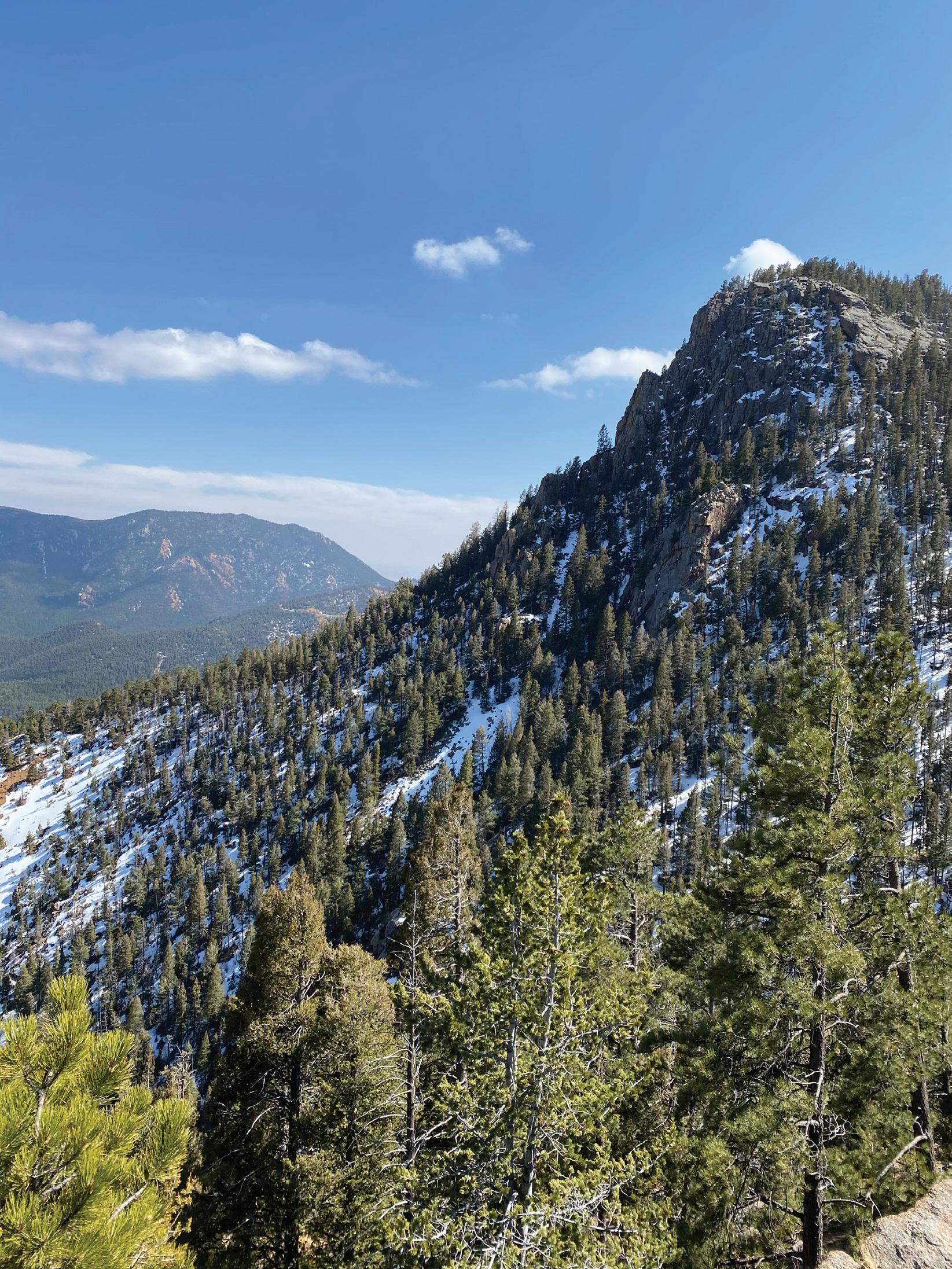
• Gay man here with an observation to share. My husband sucked my cock like a madman when we first met. We’ve been together for 12 years now and he doesn’t suck my cock like that anymore — but I’ve watched him suck the cocks of other men like he used to suck mine. I think a desire to show someone how much you want them inspires a person to suck cock like that. Once you’ve got someone, you’re not as inspired. My advice to straight couples: Want to see your wife suck cock like she used to? Watch her suck someone else’s. Want your cock sucked like that? Get someone else to suck it.


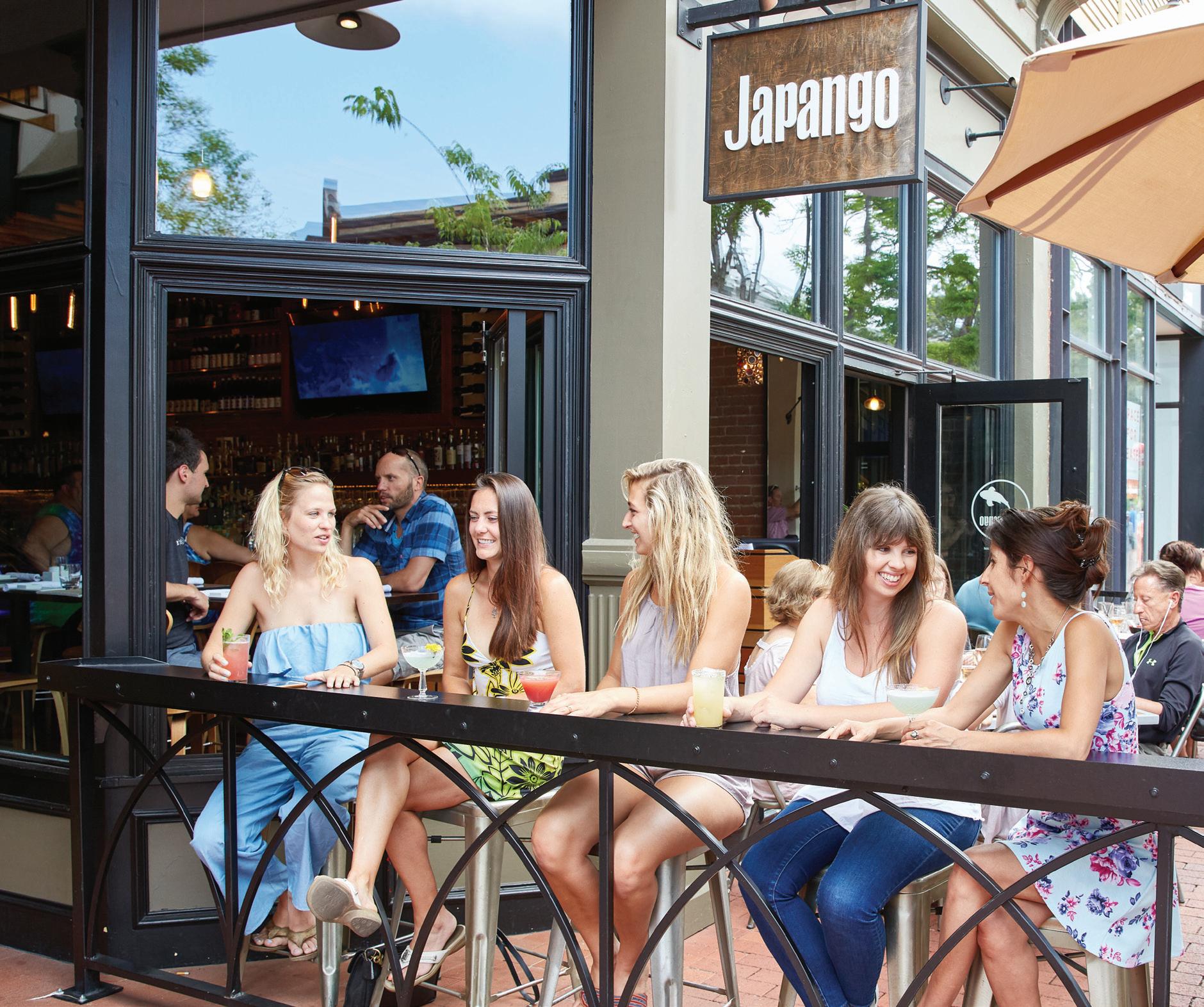






Before my career in culinary journalism, I was a Boulder restaurant cook. I was burned by hot fryer oil, injured in walk-in freezers, sliced off fingerprints, and dripped until my sweat ran dry. I also learned the nature of omelets, soups and sauces, and the drug-like high of feeding a crowd of people from a tiny kitchen. It was addictive, but always came at a cost.
Two things have always seemed true to me as a cook and a critic: Most people have no idea what actually happens in restaurant kitchens to make those hot, crispy onion rings arrive promptly at your table. Waiters, bartenders and hosts get most of the glory and the money, not the easy-toblame cooks and dishwashers hidden in the “back of the house.”
In honor of Labor Day, Boulder Weekly gave local chefs and cooks some space to talk about the ups and downs of Boulder kitchen work in their own words.
Zak Amadeus is a culinary artisan at Colorado’s Dark Steele Gastro Arts Catering. Amadeus has cooked at the
Boulder Dushanbe Tea House and Spice of Life Catering:
“There is a lot the public doesn’t see and can’t comprehend. You button up your chef coat as you enter the kitchen. You have a huge dedication to your crew, but it’s more like a pack of wolves. Somehow, this wolf pack pulls it together to do all the work required to execute an astonishing meal that appears in front of each guest. The diners imagine a magical red button that produces food instantaneously.
Salaried restaurant chef life can take everything you have and crumble it into the fire. The sound of the machine spitting out order tickets keeps you up at night. With catering, I’ve cooked in castles, mansions, night clubs, wildlife preserves and backstage at music festivals, and I’ve fed Harrison Ford, Jack Johnson, the governor and Fat Joe. I’ve found [catering] to be way more rewarding.”
Tony Hessel is the executive chef at Brasserie Ten Ten in Boulder. He has run kitchens at West Flanders Brewing Company, Pour La France, Via Perla

and other restaurants. He crafted the famous happy hour menu at the nowclosed Mediterranean Restaurant:
“I’m 59 now. I was at work at 2 a.m. today to bake bread for service, even though we also get bread from a bakery. I also make all the pastries — but I’m happy every day when I get up. It’s the career that I wanted since I was a kid. I’m the insane one who’s still doing it because I like the kitchen.
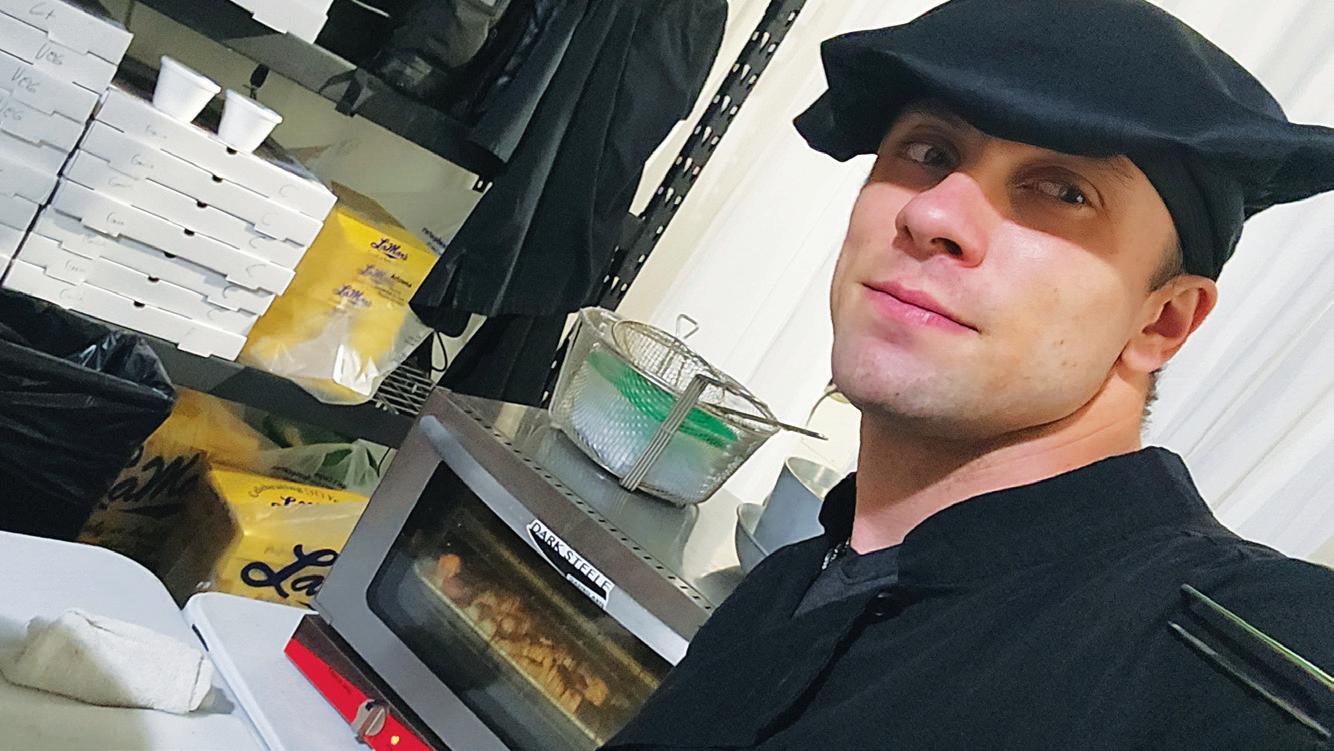
When you’re young, you work 18-hour shifts and two jobs because you’re gonna live forever. In my late 40s, I had a heart attack, a wake-up call that you cannot push yourself 24/7, 365 days a year. Nowadays, I have to physically maintain my body to work my shifts. Over the years there have also been knife wounds, burns, bad knees and a dislocated ankle.
Most customers don’t understand that they’re just one of many customers waiting on [food from] the kitchen. They don’t see the line of tickets or hear all the screaming and yelling. When people come back to see me, they are always surprised how hot and small the kitchen is.
Customers are unaware of the dance, that it takes nine people working 12 hours to put together your food. People work sick, people work injured, and accidents happen almost on a daily basis in a kitchen.
When they complain about prices, guests don’t know that every food pur-
veyor adds a fuel charge to [my] order just to show up in [my] back door. It may be just a plate of fries, but Kennebec potatoes — which used to be $30 — is now $70 a case. Luckily, our regulars are the most wonderful people in the world.”
Chef Paolo Neville is the owner of Lafayette’s Urban Hot Dog Collective and has run kitchens at 95a Bistro, Brasserie Ten Ten and The Med: “I’m a bit of an adrenaline junky. Working in kitchens, there is a constant timeline on everything you do, whether
it’s getting ready for service or keeping the ticket times fast in the middle of a rush. If I’m methodical, it can be smooth and easy. One downside of a chef’s life is I’ve lost touch with old friends because I’m always busy nights and weekends. The kitchen for me is my safe and healing place. It’s just where I feel most at home.”


One longtime Boulder chef agreed to share their experiences anonymously: “I think it is a very strange time for restaurants. It’s a tough business with
labor and food costs through the roof along with more regulations. For customers, this tipping thing is very confusing with all the additional fees on your bill. I don’t think it is the customer’s job to think about who gets paid what.”
John Hinman is the owner and head baker at Hinman Pie. He was a pastry chef at Roy’s, Vesta Dipping Grill, and The Post in Lafayette:

“The best thing about cooking and baking is watching a customer take that first bite and catching the thought on their face when they taste something for the first time. The worst thing is when that face makes a sour look. I do wish customers appreciated
the hours required to source ingredients and produce the dish. Sometimes people say: ‘You know what you should do?’ And my reply is always: ‘You should buy my company and you may do whatever you like.’ “



James Van Dyk is the former owner/chef of the Gateway Cafe in Lyons and has worked as a chef at Lucky’s Cafe, Greenbriar Inn and other eateries from New York City to Japan:
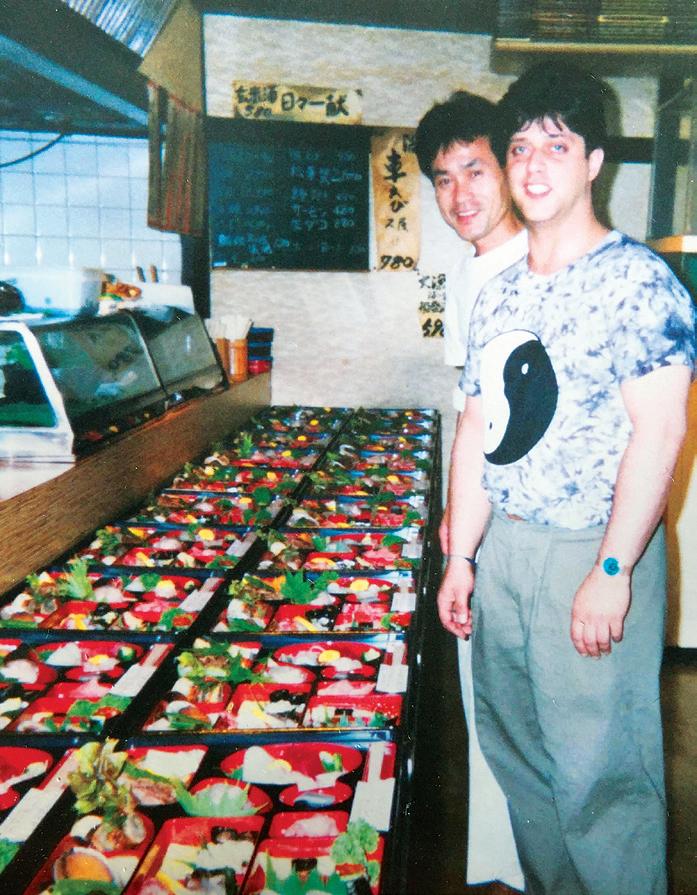
“Sadly, I physically can’t work in a kitchen any longer, but I will forever be grateful for the traveling opportunities and friends I made along the way. So many wonderful loyal guests supported me. My advice to the new chefs entering the business is to never stop learning, study the classics, and always have a plan B. If your dream is to open your own place, buy the dirt.”
John Lehndorff cooked in numerous Boulder eateries including the Greenbriar Inn, Café Circolo, Potter’s, Good Taste Crepe Shop, Alpha Phi Sorority and Savory Spice Catering.




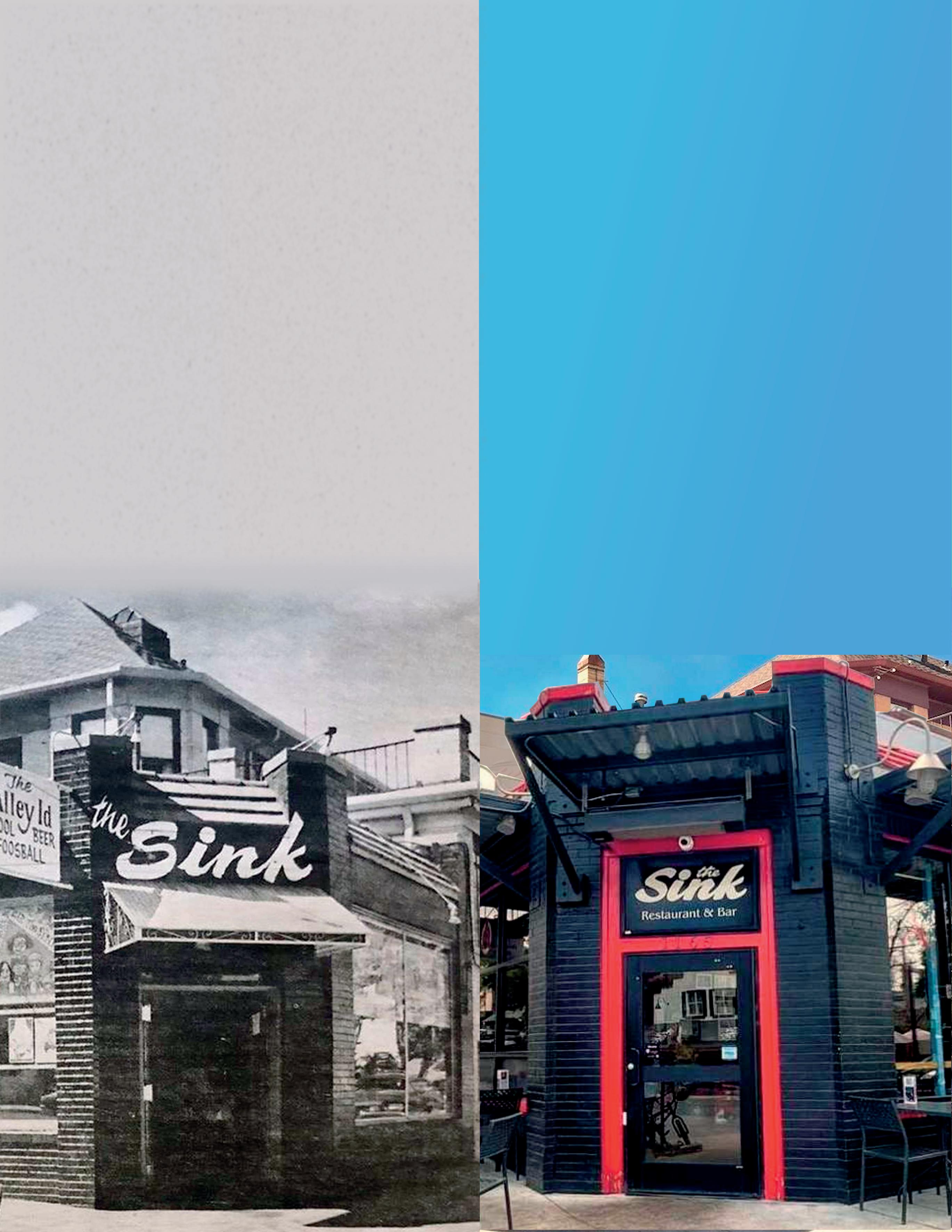















 BY COLIN WRENN
BY COLIN WRENN
Sometime in 2015, there was a moment when Anthony Bourdain and Questlove sat down at the original Yardbird to feast and discuss music and Miami. The original location had opened in the city a few years earlier, and it was starting to attract some high-profile clientele.
This was before owner John Kunkel was an internationally renowned restaurateur. It was a simpler time, when he and an opening team were developing a menu based on a lot of his old family recipes.

Looking at the recently debuted Denver Yardbird, a nearly 15,000-square-foot temple to friedbird fineries in RiNo, it’s clear something clicked. Since the opening of the original South Beach location in 2011, Kunkel’s 50 Eggs Hospitality has grown to include Wakuda, a Japanese fine-dining concept with spots in Singapore and Las Vegas; Chica, Lorena Garcia’s Latin American restaurant with an outpost in Aspen; as well as seven iterations of Yardbird. The most recent launched in Chicago and Denver.
At the latest — and largest — iteration, the massive space is broken

down into the main restaurant, a colossal bar, an event space and a courtyard complete with a stage, a sizeable dancefloor and a smoker larger than most Cap Hill apartments. The primary dining room features a view of the kitchen, where a Jasper Rotisserie Oven sits prominently.
“The kitchen is like a football field back there,” Kunkel says. “I think it’s as big as our original restaurant.” The back patio is covered in murals, with an aesthetic Kunkel says was inspired by the endless array of street art covering
Miami’s Wynwood neighborhood. With much of the building’s original bones still in place, the property exudes industrial opulence and downtown cool.
While it’s easy to be wowed by the venue’s splendor, the real magic is still in the food. “The idea of [Yardbird] is they’re kinda the anti-chain,” says Kunkel. “We really try to find teams who can operate independently.”

Kunkel says finding a high-quality local chef is the baseline. Teams are encouraged to develop new menu items, with the best being introduced to locations across the country.
Denver is expected to have up to 15 of its own special dishes as the concept gets its regional bearings.

“I was meant for this job. This job was meant for me,” says executive chef Brent Turnipseede, a Le Cordon Bleu College of Culinary Arts in Austin graduate who has since refined his talents in a number of top kitchens in

Colorado, including Denver’s Guard and Grace and American Elm. “There will be nothing we can’t do.”
Turnipseede says he’s excited to work with such an impressive team and the seemingly endless tools they have at their disposal. His career has been defined by dishes that nod to Southern traditions and cozy American fare while using the kind of techniques usually reserved for white table cloths, much in the same fashion as corporate executive chef Patrick Rebholz, a Charleston native who has been onsite overseeing the Denver opening.
While the dining experience is decidedly vivacious, what Kunkel describes as “polished casual,” the food itself sits squarely in the realm of the finer things. The famous deviled eggs come topped with smoked trout roe and the housecured pork belly is joined by compressed Palisade peaches and bacon jam. The whole bird — with honey hot sauce, chilled spiced watermelon, Vermont sharp cheddar cheese waffles, bourbon maple syrup — runs about $80 and is worth every penny.
Other cultivated dishes include the Calabrian chili cavatelli with charred broccoli rabe; the grilled blackened salmon filet with olive relish, pesto and watercress; and the unmissable fried green tomato BLT, which stacks house-smoked pork belly, pimento cheese, smoky tomato jam and lemon vinaigrette over a thick slab of crunchy heirloom tomato.
The whole menu is something of a masterclass in how to make messy look ever so chic.
Ground-level ozone is invisible and the Front Range’s biggest air quality issue. Created from pollutants like car exhaust, ozone is a leading cause of respiratory problems. Improving our air quality takes all of us, and there are many ways to help.
We encourage you to #JustSkipTwo car trips a week, mow your lawn after 5 p.m., don’t idle your car, telework a few days each week, and take the bus, bike, or walk.

Sign up for air quality alerts and learn more about the simple steps you can do to help.


If you could see Colorado’s air, you would want to improve it.
18-34, among whom it has risen 18 points since 2018,” the firm’s analysis states. “That compares with a 13-point increase among middle-aged adults and virtually no change among those 55 and older.”
Gallup also notes that cigarette use among U.S. adults continues to decline. Now, only one in eight Americans smokes them, Gallup says. Of all three substances, cannabis garnered the lowest level of health concern among users.
BY WILL BRENDZADuring Colorado’s 2022-23 fiscal year, the state collected more sales tax revenue from cannabis than it did from both cigarettes and alcohol, according to a new report from the Colorado General Assembly. In fact, weed tax revenue brought in almost as much as the other two vice taxes combined. Together, cigarette and alcohol taxes totaled $290 million, while cannabis raked in $282.3 million.
Marijuana does have an edge when it comes to raising sales tax revenue. While cigarettes and alcohol are both taxed at just 2.9%, cannabis has a 15% retail sales tax. But this is the second fiscal year that pot sales taxes have outpaced that of alcohol and cigarettes.
Research published in Clinical Toxicology in December 2022 and a recent Gallup poll suggest this flip could indicate a preference shift away from traditional intoxicants and towards cannabis.

The peer-reviewed study from the journal Clinical Toxicology tracked intentional use reported to the National Poison Data System (NPDS) from 2000 to 2020. The researchers found 338,000 instances of intentional abuse or misuse among American children aged 6-18 during that time period and “an upward trend in marijuana misuse/ abuse exposures among youth, especially those involving edible products.”
That study found a 245% increase in adolescent cannabis use since 2000. Over that same period, the research found that alcohol misuse and abuse had steadily declined.
A Gallup poll from August 2023 found that younger adults view alcohol as less harmful than tobacco and more harmful than cannabis. The same poll shows that 39% of Americans now believe that consuming one to two drinks a day is bad for one’s health.
“The increased belief that moderate alcohol consumption is detrimental is owed largely to young adults aged
Colorado’s tax revenues might be starting to reflect these observed changes too. For the second year in a row, cannabis tax revenue is outpacing that of alcohol and cigarettes. Higher tax rates aside, that may indicate that more people are choosing to use cannabis over alcohol and cigarettes.
That could be a good thing for the state’s general health. Cannabis is decidedly less toxic than the other two vices. It’s a largely non-addictive, natural intoxicant that is almost impossible to overdose on. Alcohol and cigarettes, by comparison, kill hundreds of thousands of people every year. According to the National Institute on Alcohol Abuse and Alcoholism, more than 140,000 Americans die from alcoholrelated causes annually. And according to the Centers for Disease Control, over 480,000 Americans die annually from cigarette smoking.
The case could certainly be made that smoking is harmful no matter how it’s done. However, the research published in Clinical Toxicology showed that edible marijuana use had the highest monthly increases among 13-16-year-
olds year-over-year. So even among underage marijuana users, the trend leans toward the healthiest (and most discreet) form of ingestion.
As those teenagers continue to age into adulthood, and as more states legalize cannabis, it’s likely this 20-year trend reported in Clinical Toxicology will continue — which means that cannabis sales tax revenue in Colorado could continue to outpace alcohol and cigarettes in years to come. And because cannabis is taxed at such a high rate comparatively, that would mean greater revenue for the state.
The most recent Colorado General Assembly report outlines the state programs and initiatives cannabis tax revenue goes toward: Just over 2% ($6.2 million) goes to the State Public School fund; 10% ($28.2 million) is distributed to local counties and municipalities; 15% goes toward the Marijuana Tax Fund (which funds 16 different state agencies); a portion is allocated to the Building Excellent Schools Today (BEST) Act, and another portion is earmarked for the general fund.
Pueblo County even has a college scholarship program funded by local cannabis sales tax revenue (Weed Between the Lines, “Sin tax scholarships”, March 30, 2023).
The fact that cannabis sales taxes have outpaced those of alcohol and cigarettes for the last two years seems to reflect a shift in young people’s preferences and perceptions of these substances. And if that trend continues, Colorado’s ability to fund its public programs through cannabis should continue to grow as well.

Young people are shifting away from alcohol and cigarettes — and toward cannabis







